

PRSRT STD U.S. POSTAGE PAID Bolingbrook, IL Permit No. 1939 www.themunicipal.com The Premier Magazine For America’s Municipalities June 2023 INSIDE: MurCal Colorado Springs restores North Douglas Creek Channel Pilot program blends hydrogen with natural gas Water & Energy

2 THE MUNICIPAL | JUNE 2023


JUNE 2023 | THE MUNICIPAL 3
17 Focus on Water & Energy

40 Municipal Management: Marijuana sales benefit Michigan communities
44 Parks & Environmental Services: Perseverance reconnects coastal town to its legacy
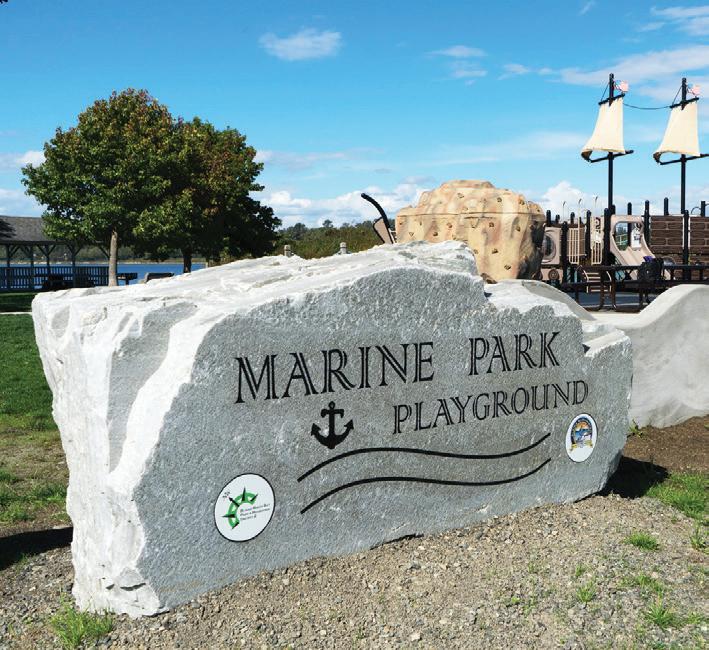
46 Municipal Management: Small town acts to capitalize on new-found fame



48 Waste & Recycling: There’s dedication to community composting in Decorah


52 Streets, Highways & Bridges: Cedar Rapids, Iowa, to incorporate 20 roundabouts to improve public safety
54 Streets, Highways & Bridges: San Antonio partnership helps business owners recuperate from double whammy

Contents 18 Focus on Water & Energy: Massachusetts communities turn to municipal energy aggregation 22 Focus on Water & Energy: Stormwater project completion fixes channel erosion in Colorado Springs 26 Focus on Water & Energy: Going green to save green: Inside Augusta’s energy upgrades 28 Focus on Water & Energy: Hydrogen blending pilot programs are looking for solutions to reduce carbon emissions 32 Focus on Water & Energy: New York water project highlights pros of communities working together
June 2023 | VOL. 14 No. 3 | www.themunicipal.com
www.themunicipal.com June 2023
MurCal Colorado Springs restores North Douglas Creek Channel Pilot program blends hydrogen with natural gas
& Energy ON THE COVER Huntington Beach, Calif., meets most of its water demand from groundwater wells
throughout the city. It turned to MurCal’s
to save money and improve efficiency and performance, especially during natural disasters and emergencies. Learn more on page 10. Shutterstock photo 4 THE MUNICIPAL | JUNE 2023 18 28 44 54
INSIDE:
Water
located
panels

JUNE 2023 | THE MUNICIPAL 5
publisher RON BAUMGARTNER rbaumgartner@the-papers.com

editor-in-chief
DEB PATTERSON dpatterson@the-papers.com
editor SARAH WRIGHT swright@the-papers.com

publication manager CHRIS SMITH chris@themunicipal.com
senior account executive REES WOODCOCK rees@themunicipal.com




graphic designer
MARY LESTER mlester@the-papers.com

business manager
ANNETTE WEAVER aweaver@the-papers.com

mail manager
KHOEUN KHOEUTH kkhoeuth@the-papers.com

director of marketing
STEVE MEADOWS smeadows@the-papers.com

marketing assistant

TAELYNNE OUSLEY tousley@the-papers.com
Contributing Writers
Ray Balogh, Jennifer Barton, Beth Anne Brink-Cox, Lauren Caggiano, Nicholette Carlson, Denise Fedorow, Kevin Kilbane, Dani Messick, Staci Reafsnyder, Julie Young
Beth Anne Brink-Cox
Beth Anne Brink-Cox has worked as a journalist periodically since high school. She also writes and has published poetry; additionally, she has two different memoirs in progress. Brink-Cox reads voraciously and collects unbelievable quantities of books, but she’s willing to share and often gives many away. Married to a man who introduced amazing creativity into her life, she is also a daughter/caregiver and a mother to her daughter as well as one Yorkie and two cats. When not reading or writing a daily occurrence her next biggest passion is community theatre, especially directing.

PO Box 188 • 206 S. Main St., Milford, IN 46542 866-580-1138/Fax 800–886–3796 Editorial Ext. 2307; Advertising Ext. 2505, 2408 or 2489 WWW.THEMUNICIPAL.COM The Municipal does not knowingly accept false or misleading advertising or editorial content, nor does The Municipal or its staff assume responsibility should such advertising or editorial content appear in any publication. The Municipal reserves the right to determine the suitability of all materials submitted for publication and to edit all submitted materials for clarity and space. The Municipal has not independently tested any services or products advertised herein and has verified no claims made by its advertisers regarding those services or products. The Municipal makes no warranties or representations and assumes no liability for any claims regarding those services or products or claims made by advertisers regarding such products or services. Readers are advised to consult with the advertiser regarding any such claims and regarding the suitability of an advertiser’s products. No reproduction of The Municipal is allowed without express written permission. Copyright © 2023. 8 Editor’s Note: Utilities face challenges, but also innovations 10 From the Cover: MurCal Inc. 12 On the Road Again: Walt Disney Hometown Museum, Marceline, Mo. 38 Personality Profile: Mayor Satya Rhodes-Conway 56 Conference Calendar 57 Product Spotlights 58 Company Profile: SL Environmental Law Group 62 News & Notes 66 What’s in a Name: Chilhowie and Farmville, Va. 68 Top 10: Create times the kids will remember 69 Advertiser Index Departments
Meet our Staff
6 THE MUNICIPAL | JUNE 2023
Meet our writers
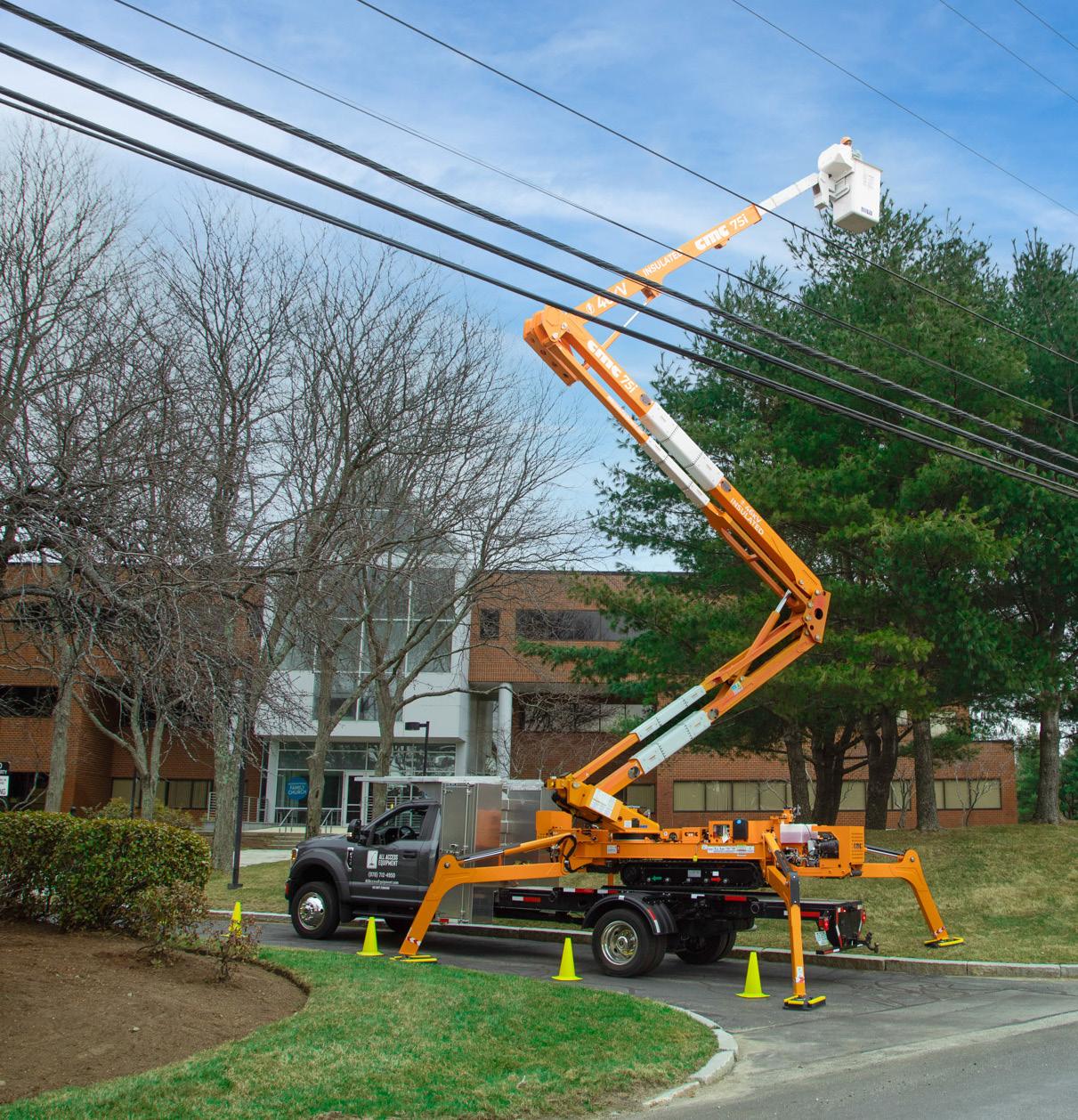



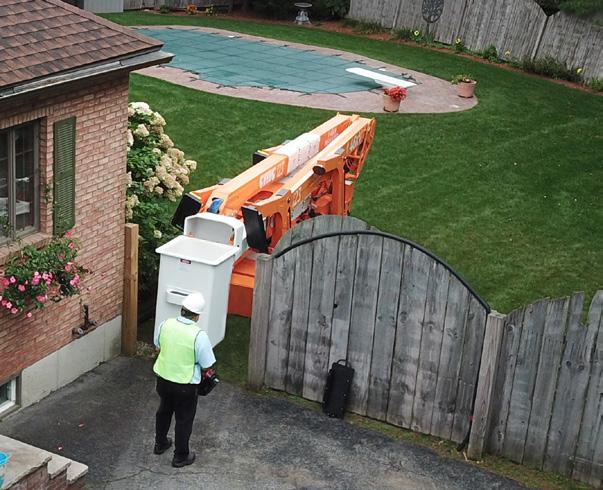


GET A QUOTE! (978) 712-4950 sales@allaccessequipment.com allaccessequipment.com Indoor/Outdoor Schools & Universities Towns & Municipalities CALL FOR A FREE DEMO ! INSULATED TRACKED AERIAL LIFT CMC 2 LIFTS FOR THE PRICE OF 1: TRUCK MOUNT OR SELF-PROPELLED JUNE 2023 | THE MUNICIPAL 7
Utilities face challenges, but also innovations
 Sarah Wright | Editor
Sarah Wright | Editor
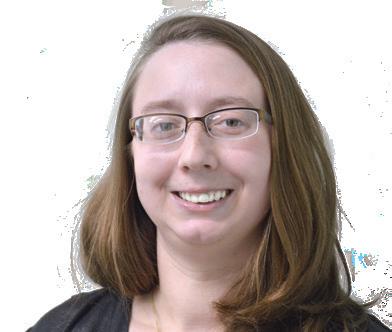
We often take flowing water and ever-present electricity for granted despite how dependent we are on them. Because I watch too many list videos, I spend more time than I probably should speculating what the world would be like in a post-grid world following a massive geomagnetic storm. Of course, I consider my own prospects in such scenarios. Sadly, with each outage, I always find my odds are not good even if I invest in more items to make outages more bearable. And since I’ve purchased my propane heater, the power has remained on every winter after that bitter day when I had to huddle under blankets while wearing my winter coat. Go figure!
However, despite our dependence on water and energy, their current state is troubling. Both received a C- grade from the American Society of Civil Engineers in the organization’s 2021 report card. For energy, weather remains an increasing threat. The report notes, “Among 638 transmission outage events reported from 2014 to 2018, severe weather was cited as the predominant cause.”
Cyber threats and even vandalism are also concerns. In December 2022 and January 2023, gunfire damaged three North Carolina power substations. Across the country, Washington and Oregon have experienced similar attacks. Substations are often isolated and lightly protected by chain-link fencing and barbwire, making them attractive targets for those who would do such acts. Erroll Southers, professor of national
and homeland security at the University of Southern California, noted the difficulties when speaking to NPR for a Jan. 18, 2023 article, “Another North Carolina power substation was damaged by gunfire.”
He told NPR, “The grid is extremely large. It has about 6,400 power plants across the country, some 55,000 substations and over 450,000 miles of high-voltage transmission lines serviced by 3,000 companies.... It’s extremely challenging to monitor and protect. And many of these places are very remote, and so officers have to get there. And by the time they do, the attackers are already gone.”
While the ASCE report card expresses concerns, it notes both water and energy utilities are being proactive, increasing spending to improve their systems and build in resiliency.
This issue of The Municipal is highlighting some of these efforts. Writer Kevin Kilbane writes about Massachusetts’ use of community choice energy aggregation programs to not only ensure competitive pricing but also to further renewable energy. Then out of Minnesota, writer Denise Fedorow shares an innovative pilot program where a utility blends hydrogen with natural gas. On the water side, Beth Anne Brink-Cox highlights a sizeable water project that has brought the town of Verona and the city of Rome, N.Y., together.
While utilities face challenges with funding, aging infrastructure and the sheer scope of some systems, there are those hitting the ground running while working innovation along the way.
Editor’s Note 8 THE MUNICIPAL | JUNE 2023 M

JUNE 2023 | THE MUNICIPAL 9
Improve water operations with an all-purpose, highly configurable engine controller
By SILVIA CORRADIN | MurCal

Huntington Beach, Calif., is an epicenter of activity and entertainment with wide, sandy beaches, ideal weather and a charming community. The city offers residents a diversified economy overflowing with good jobs, a wide variety of housing, an excellent educational system, boat marinas and numerous parks.
Named for railroad magnate Henry Huntington, who orchestrated its development, this seaside city in southern California’s Orange County serves almost 200,000 residents. Incorporated in 1909, Huntington Beach is 35 miles south of Los Angeles and 90 miles north of San Diego. The Pacific Ocean borders it to the west, with Costa Mesa/Newport Beach to the east. With its 9.5 miles of beautiful beach, mild climate and excellent surfing, it has earned the moniker Surf City. Huntington Beach officially adopted the Surf
ABOVE: Huntington Beach, Calif., turned to MurCal’s Series 800 control panel to operate one of its well pumps and monitor chemical levels. The city plans to upgrade all 15 of its stations from the older panels to the new Series 800 soon. Pictured is Chris Ramirez from HB Public Works.

City USA nickname in January 2008, and it holds more than 50 surf contests each year, including the legendary US Open of Surfing. While residents and visitors enjoy the recreational water activities, quietly working behind the scenes, the Huntington Beach Utilities Operations keeps the city safe from flooding, clean from wastewater and keeps the water flowing.
The organization maintains 15 stormwater pumping stations. Its storm water maintenance is responsible for cleaning the 135
10 THE MUNICIPAL | JUNE 2023 M From The Cover
(Photos provided by MurCal )
miles of stormwater pipes, as well as the 1,700 catch basins that can fill with rain, trash or materials. This function is vital as, without proper stormwater control, areas of the city could be susceptible to flooding during storms. The city is also responsible for maintaining 350 miles of wastewater piping and 27 sewage lift stations, which transport an estimated 24.3 million gallons a day of wastewater for treatment.
Huntington Beach meets the majority of its water demand from groundwater wells located throughout the city from 10 operating water wells that vary in depth from 250 feet to 1,020 feet, with production ranging from 450 gallons per minute to 3,000 gpm. Total output from all 10 wells is rated at 30,000 gpm.
Its water system includes four reservoirs with a combined capacity of 55 million gallons and four booster stations with a combined capacity to pump 44,365 gpm into the water system. The distribution system comprises approximately 590 miles of pipeline, 5,670 hydrants and more than 15,000 valves.
The city’s utilities division makes extensive efforts, along with a diligent water quality monitoring program, to ensure that the public drinking water system exceeds the EPA and the California Department of Public Health standards.
We recently visited one of the city’s newest stations Well 1A and the operator gave us a tour of the facility, which has been in operation for about three years. In this particular location, an empty lot with a submersible well pumping 500 gpm was upgraded to 3,000 gpm, and the facilities blend into the neighborhood by design.
After looking at several solutions to control this new station, the city decided that instead of going through the expense of a large PLC installation with a company that did generic controls, they would work with a company focused on municipal water solutions.
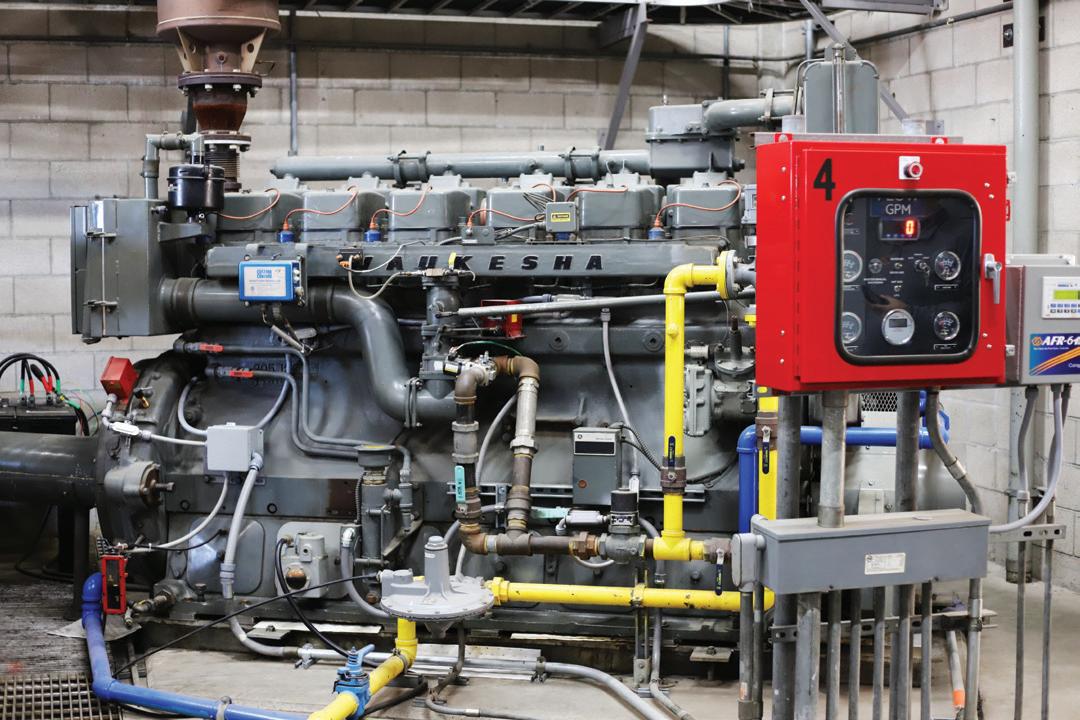
They installed MurCal’s Series 800 control panel to operate the well pump and monitor chemical levels. Designed to work with a multi-engine system, the 800 Series Panel is a Full-Featured Municipal Pump Control Panel. Many municipalities use these S800 Panels for their pump/flood/lift stations. It is an all-purpose, highly configurable engine controller designed to meet the needs of nearly every municipality. Engineered to be a municipal-specific platform, the controller incorporates the necessary hardware to execute these projects efficiently.

The Huntington Beach team started using MurCal’s panels in the mid-1980s for flood control and has been very happy with this solution’s reliability and service, and they felt the price point was fair. They particularly liked the fact that MurCal is in southern California; hence, service calls are handled quickly.
Many of the city’s older stations now have panels that are 25 years old, making it harder to maintain and upgrade if they encounter a problem. According to the veteran operator, the city has had such a good experience with MurCal that it wants to continue that relationship by upgrading all 15 of its stations from the older panels, which vary from the Series 500, Series 555 and Series 600, to the new Series 800 in the near future.
According to operator Chris Ramirez, “The new panels are even better technologically and in manufacturing. They are solid, and they just work they don’t break.”
Ramirez additionally stated that they had the challenge of a mix of electric motors and natural gas engines. There were many electric motor options, but people with experience with large gas engines were harder to find, and MurCal’s panels were the best in their experience with the throttling and staging and keeping everything under control. More importantly, they have the ability to work with both engines and electric motors without expensive add-on modules and software.
Innovative technology can save money in the long run and improve efficiency and performance, especially during natural disasters and emergencies. Taking the time to do it right before an emergency arises is the best insurance. MurCal is with you every step of the way, ensuring your installation is perfect and that you understand all the benefits of your new system from day one.
For more information, visit https://www.murcal.com/
This control room, running the previous generation S600 panels, is located at a booster station across town and operates four engine/electric motor combination pumps. It is scheduled to be upgraded to S800 based controllers in the near future.
JUNE 2023 | THE MUNICIPAL 11
MurCal also offers local instrumentation near the engine that feeds back to the control room. These panels can contain ignition and air-fuel ratio controllers as seen on this Waukesha 35421G.
Walt Disney Hometown Museum Marceline, Mo.
 By RAY BALOGH | The Municipal
By RAY BALOGH | The Municipal
Disneyland did not start in Anaheim, Calif. Nor was Disney World first established in Orlando, Fla.
Such unrivaled world-renowned family attractions are the manifestations of myriad plans, measurements and prototypes, themselves the products of initially intangible ideas. And those ideas arise from the creative imagination and unstoppable passion, in this case, those of a young farm boy from Marceline, Mo. Walter Elias Disney.

The Disney family —Elias and Flora and their children, Herbert, Raymond, Roy, Walt and Ruth moved to the quiet burg of Marceline when Walt was 4 years old.
Too young to contribute much to the farm work, young Walt spent his days dreaming and imagining a halcyon fantasy world he longed to share with other children. “I hope the youth of today and the future know a childhood as
happy as was mine in Marceline,” he said decades later of his unchangeable dream.
His favorite venue for felicitous contemplation: The Dreaming Tree, a large cottonwood situated on the farm. Walt would often sit under the tree and draw or imagine stories. His heart was never far from his hometown, and he incorporated various elements of his years there, such as the family barn, rustic surroundings and the cartoon characters he conjured during his unfettered meditations, into his films, movies and theme parks.
Walt Disney’s love affair with Marceline is returned in earnest by the town of 2,125 residents, which will “forever” remember Walt as its favorite son and “will never forget that the legendary Walt Disney began his journey in this small American town.”
Walt Disney ((Public domain via Wikimedia Commons))
TOP PHOTO: The main street of Marceline has been dubbed by many as the “Real” Main Street U.S.A. (Photo courtesy of duchessofdisneyland.com)
12 THE MUNICIPAL | JUNE 2023 M On The Road Again
A simple unadorned sign welcomes visitors to Walt Disney’s boyhood hometown of Marceline, Mo. Disney’s family lived on a farm not far from town, and the town’s tagline, “Small Town America — Perfectly Imagined!” gives tribute to Walt’s young days of sitting under a tree on the farm and conjuring the characters he would give life to later on. (Photo by waltdisneymuseum.org)
In 2001, to commemorate Disney’s 100th birthday, the nonprofit Walt Disney Family Foundation opened the 10,000-square-foot Walt Disney Hometown Museum in the restored Santa Fe Railway Depot, acknowledging the man’s lifelong love for trains.
The museum contains more than 4,000 artifacts, including personal family items and personal correspondence, gifts Disney gave to the town, photographs and original artwork by a graffiti artist, a reproduction of the elementary school Disney attended and a gallery of items donated or loaned by Disney collectors around the world.
Other locations throughout Marceline celebrate the life of the boy with the big imagination:
Disney Family Farm
The Disney family moved to the farm in 1906. According to the museum’s website, “It was on this very land that a young Walt Disney would say he found the magic of his life. On this farm, Walt held his first live show, developed his love for nature and had a special place under his Dreaming Tree.”
The land is privately owned, but guests are welcome to visit the barn 365 days a year from sunrise to sunset at no cost and are permitted to leave their signature or a note in the barn.
Because the farmhouse is a private residence, guests are asked to be respectful.
Walt Disney Elementary School
In 1960, Walt Disney personally dedicated the new elementary school in Marceline. He donated state-of-the-art equipment, textbooks and every single Disney educational product available. He also donated custom playground equipment. Murals throughout the school with some of the most famous Disney characters are regularly restored.
At the dedication ceremony, Walt presented the school with an orange Mickey Mouse flag now displayed at the museum that had been flown over his apartment in Disneyland and presented a flagpole from the 1960 Winter Olympics, for which he was the chairman of the Pageantry Committee.
Walt Disney Post Office
In 1968, two years after his death, the United States Postal Service issued a commemorative Walt Disney stamp. In 2003, Congress officially renamed the location as the Walt Disney Post Office, the only federal building named after him.
Walt Disney Municipal Park
Originally built by the Santa Fe Railroad, the park was officially renamed in 1956.
Main Street USA
Main Street USA is a staple of Disney Parks around the world. The street was originally known as Kansas Avenue and is now marked with special mouse ears street signs that Mickey himself unveiled.
EP Ripley Park
The park is named after the president of the Santa Fe Railroad. The Disney family visited the park quite often.
Coke Wall
A young Walt Disney remembered the CocaCola Wall from his years in Marceline. The mural was also to be lost for many years, as another building was constructed in front of it. Years after Disney moved away, that building burned down, revealing the Coke Wall once again.
The Walt Disney Hometown Museum is located at 120 E. Santa Fe Ave., Marceline, Mo., and is open 10 a.m. to 4 p.m. Tuesday through Saturday and 1-5 p.m. Sunday.


Adult admission is $10; youth (6-12 years), $5; seniors and military, $9; and children under 6 are free.
For more information, call (660) 376-3343 or visit waltdisneymuseum.org.
The Walt Disney Hometown Museum is housed in the former Atchison, Topeka and Santa Fe Railway depot. (Photo by waltdisneymuseum.org)
JUNE 2023 | THE MUNICIPAL 13

14 THE MUNICIPAL | JUNE 2023



































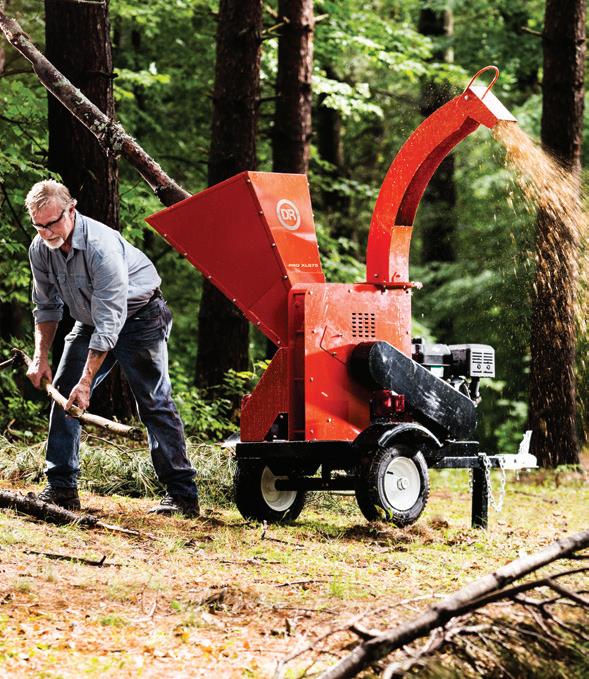













SOME LIMITATIONS APPLY FREE SHIPPING SALE! NOTHING STOPS a DR® GoDRpower.com DR POWER EQUIPMENT Go online to request your FREE PRODUCT CATALOG There’s a DR ® for every corner of your property— See more equipment online! Brush Piles Chipper Shredders Vines & Weeds Trimmer Mowers Tough Brush Field and Brush Mowers Large Lawns Electric Zero-Turn Mowers Acres of Leaves Leaf and Lawn Vacs JUNE 2023 | THE MUNICIPAL 15







SAN DIEGO CONVENTION CENTER August 27-30, 2023 | #PWX2023 MAKE PLANS TO BE IN SAN DIEGO FOR APWA’S ANNUAL CONFERENCE • New Technologies • Exciting New Networking Opportunities • New Education Formats & Great New Ways to Learn For more information visit: pwx.apwa.net REGISTER ONLINE! SAVE $100 REGISTER BY JUNE 30, 2023 16 THE MUNICIPAL | JUNE 2023
1,200 tons
The expectation for the hydrogen-natural gas blending pilot project is that annually CenterPoint is avoiding about 1,200 tons of CO2 emissions because the green hydrogen is displacing some of the natural gas that otherwise would’ve been emitted. That is equal to the annual use of 140 homes.

Learn about utilities piloting the blending of hydrogen with natural gas on page 28.
351
As of March 2023, about half of the state’s 351 cities and towns had sought and received state department of public utilities approval to operate a community energy aggregation program.
Energy Focus on: Water &



Colorado Springs, Colo., received a Pre-Disaster Mitigation grant from the Federal Emergency Management Agency. This grant provided 75% of the North Douglas Creek Channel improvement project’s funding and required a 25% match from the Colorado Springs Stormwater Enterprise.

$0
Net cost of a citywide HVAC system upgrade in Augusta, Ga., that began in the spring. The city borrowed $24 million to contract with a heating company to upgrade and modernize the HVAC systems in all city-owned buildings and will pay back the loan with the guaranteed savings from the upgrades.

Read more on page 26.

$28.2 million
Traverse City, Mich., is borrowing up to a combined $28.2 million to build out its smart grid. Mayor Pro Tem Amy Shamroe points to the increasing importance of municipalities upgrading to more secure, sophisticated grids in an era of surging cyberattacks on energy infrastructure, while Commissioner Tim Werner said the infrastructure is crucial to meet ing future energy needs and climate change goals. The plan will also increase fiber internet availability across the city.
Source: https://www.traverseticker.com/news/city-commissioners-support-borrowingadditional-10-million-for-smart-grid-buildout/.

25%
About a quarter of residents in the Rio Valley Foothills have been without reliable access to water since the beginning of the year, when Scottsdale, Ariz., cut off access as a step in its drought management. A potential solution was voted down by the state’s House of Representatives in March.
Read a primer on situation at https://www.axios.com/local/phoenix/2023/02/22/rio-verde-foothills-water-crisis-scottsdale-drought and see the latest update at https://www.abc15.com/news/region-northeast-valley/scottsdale/ arizona-house-votes-against-bill-that-would-bring-water-to-rio-verde-foothills.
Twenty-two Municipal Climate Action Plan recommended activities were unanimously adopted by Asheville, N.C., in March. The move will update the city’s 2009 Sustainability Management Plan and identify policies and resolutions that are most impactful at carbon mitigation and climate resiliency. The activities are prioritized based on impact, feasibility and opportunities to advance equity.
Source: https://www.ashevillenc.gov/projects/ municipal-climate-action-plan/.

25%
Learn more about this project and how it will improve stormwater and reduce flooding on page 22.
Find out more about Massachusetts municipalities’ community energy aggregation programs on page 18.
22
JUNE 2023 | THE MUNICIPAL 17
Massachusetts communities turn to municipal energy aggregation
By KEVIN KILBANE | The Municipal
Lancaster, Mass., has been an early-adopter with energy programs.
The town of about 8,500 people moved quickly to join Massachusetts’ Green Communities program, which encourages municipalities to reduce energy consumption by 20%. Lancaster likely was the first community statewide to install a municipally owned solar energy array on a brownfield site, said Orlando Pacheco, the town administrator from 2005 to 2015 and from 2018 to 2022.
In 2012, Lancaster also became among the early Massachusetts communities to embrace municipal energy aggregation, which allows cities and towns to bundle the electricity needs of residents, businesses and municipal facilities and then seek competitive bids from electricity suppliers so community members obtain the best rates and service. The electricity continues to flow through their local utility’s distribution system.
“I think for us it was really just another step in carving out our energy identity,” said Pacheco, who now works as the town administrator for Georgetown, Mass., and as a community energy aggregation consultant for the town of Shirley, Mass.
LEFT: Community Choice Energy aggregation programs allow a community to bundle together residents and businesses and then seek electricity service bids from energy suppliers so community members can obtain the best price or achieve other energy goals. (Photo

18 THE MUNICIPAL | JUNE 2023 Focus on: Water & Energy M
provided by Kevin Kilbane)
Eleven U.S. states currently allow some form of community choice energy aggregation (sometimes called a CCE or CCA), the nonprofit Local Energy Aggregation Network (LEAN) said. In addition to Massachusetts, which was the first in the nation in 1997, states authorizing energy aggregation for cities and towns include California, Illinois, New Hampshire, New Jersey, New York, Ohio, Rhode Island and Virginia. Maryland has approved a pilot project, and an old existing law in Pennsylvania allows boroughs, which are similar to towns, to create energy aggregation programs. Community energy aggregation legislation has been proposed or discussed in several other states, LEAN reported.
So far, aggregation efforts have focused on electricity rather than other energy sources, such as natural gas and heating oil.
Massachusetts’ experience explains why more communities have shown interest in energy aggregation.
“Municipal aggregation can offer longer-term price certainty in electric supply rates, allowing residents to realize the benefits of the competitive electricity market while protecting them from the risks of individual supplier contracts,” said Danielle Burney, a spokesperson for the state Department of Energy Resources. The governor, lieutenant governor and administration also want to shift Massachusetts’ electricity supply to greener sources and away from fossil fuels.
“Aggregation can help cities and towns achieve our collective clean energy and climate goals,” Burney added.
As of March 2023, about half of the state’s 351 cities and towns had sought and received state department of public utilities approval to operate a community energy aggregation program, a research team at the University of Massachusetts at Amherst, Mass., said in their March 2023 report, “Community Choice Electricity Programs: A survey of
This graphic from the Local Energy Aggregation Network (LEAN) illustrates how Community Choice Energy Aggregation programs work. The electricity supplier provides power to participants in the community’s energy aggregation program. The electricity is delivered through the existing local electric utility. Consumers typically benefit by receiving electricity at a lower rate than normal individual basic service costs and also may obtain more energy from renewable sources or achieve other energy goals. (Provided by Local Energy Aggregation Network)
Massachusetts Municipalities.” The findings are based on data gathered from 2019 through 2022 for 97 cities and towns around the state.
Not all approved communities currently operate an energy aggregation program. Some are in the process of developing or launching their program. Several stopped offering a program.
Researchers found nearly 80% of Massachusetts municipalities with a community energy aggregation program achieved cost savings compared with their local electric utility’s monthly basic service rates, the report said. The average savings totaled $93 per household annually, or a combined total of about $70 million per year for all communities with energy aggregation programs.
Municipalities also reported rate savings for residents who opted to pay slightly higher prices for energy aggregation packages that included a greater percentage of renewable energy than required by Massachusetts law.
In addition, researchers found many communities received other benefits, such as greater price stability or obtaining a higher percentage of electricity from renewable energy sources.
JUNE 2023 | THE MUNICIPAL 19
Pacheco, who helped organize community energy aggregation programs in Lancaster and Haverhill, Mass., as a municipal staff member and in Shirley, Mass., as a consultant, believes Massachusetts’ energy aggregation program has been successful based on his benchmark providing electricity rate savings to consumers.
An aggregation can seek the best price from electricity suppliers and lock in that price for from several months to about three years, Pacheco said. The price may end up being higher than the local utility at times and lower at other times, but the rate curve is much smoother and prevents the price sticker shock individual customers can experience when a utility raises rates after entering a new energy procurement cycle. “Making sure that bill is stable certainly helps make budgeting easier,” he noted.
Massachusetts municipalities also benefit because the state set up its energy aggregation program as an opt-out system, he said. After a community receives state approval and launches its program, residents automatically become participants on a default basis. They must opt out if they want to buy electricity on their own. Municipalities don’t have to expend a lot of effort persuading residents to join the aggregation program, Pacheco explained.
Some states allow community energy aggregation programs with opt-in provisions, LEAN reported. That requires more work to attract residents’ participation.
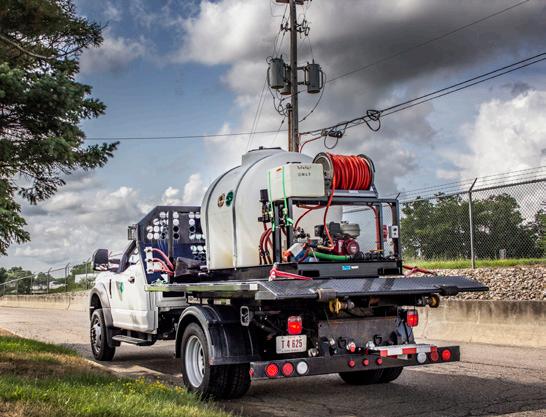


The success of any proposed or existing municipal energy aggregation program depends on education and communication, Pacheco said.



• Allow extensive lead time to ensure public education efforts reach a broad audience, he said. Use the municipality’s website, Facebook pages, social media and newsletters to inform the public. “Make sure you have all that information well in advance, and you’re putting it out there on multiple occasions,” he recommended.
• Be patient when choosing an electricity supplier and the length of that service contract, Pacheco said. Commodity markets change frequently and are influenced by many factors. “So don’t feel you have to pull the trigger at any given moment,” he added. “Make sure that, when you roll it out, you feel confident and you feel good about the product and the rate that you’ve rolled out. Because if your initial rollout is bad, not only will people not want to participate in the program, but it may cause people to want to end the program before it even really gets off and running.”
• Update residents continuously about the community energy aggregation program, even after launching it, Pacheco advised. “Just because you have an active aggregation and people are a part of it, things in the aggregation will change, regulatory items may change,” he explained. “Make sure people are aware of pricing updates and when those pricing changes will take effect. I like to be as informative as possible.”
GIVE US FIVE MINUTES, WE’LL TRANSFORM YOUR TRUCK Safely maximize your workforce with Switch-N-Go® interchangeable truck bodies. www.switchngo.com/municipalities 20 THE MUNICIPAL | JUNE 2023 continued from page 19
PREMIUM FOR THE MASSES
The all-new non-CDL Vac•Con Titan comes in a 3-yard configuration that provides the quality and performance expected from our premium Titan line of products — in a unit ANYONE can use.
Weighing in under 26,000 GVWR, the non-CDL Titan is an ideal option for smaller organizations and those who need to be able to jump in the truck and go — no CDL required.
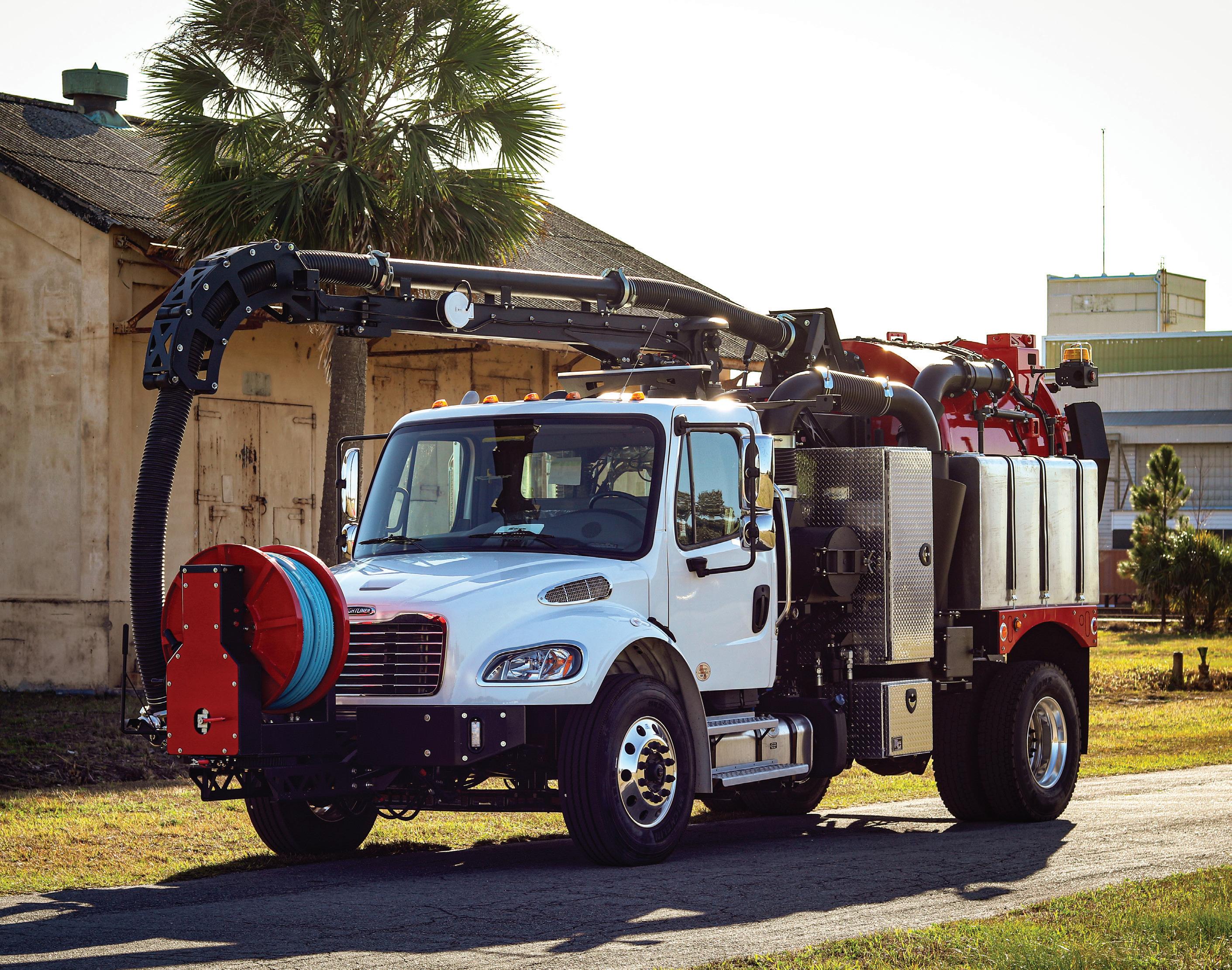
JUNE 2023 | THE MUNICIPAL 21
Stormwater project completion fixes channel erosion in Colorado Springs
By NICHOLETTE CARLSON | The Municipal

22 THE MUNICIPAL | JUNE 2023 Focus on: Water & Energy M
A stormwater project involving the North Douglas Creek Channel acting as a drainage channel was recently completed in Colorado Springs, Colo. While the North Douglas Creek Channel has always existed as a natural drainage channel for stormwater beginning on the west side of Colorado Springs and leading to Monument Creek, it was altered as there was an increase in development on the west side of Colorado Springs. According to Colorado Springs Stormwater Enterprise Manager Richard Mulledy, “The channel conveys up to a 100-year rainfall event through the city to Monument Creek.”
When the Environmental Protection Agency performed an audit of the city in 2013, issues with the North Douglas Creek Channel were found. These issues were then addressed in the city’s intergovernmental agreement with Pueblo County. During the audit, it was discovered that a section of the North Douglas Creek Channel had suffered serious erosion, which was causing damage to adjacent properties, area utilities and threatening the adjacent railroad tracks and Sinton Road.

In order to fund the North Douglas Creek Channel project, the city of Colorado Springs utilized multiple funding partners. The city applied for a competitive Pre-Disaster Mitigation grant through the Federal Emergency Management Agency and was awarded the grant. This grant provided 75% of the project’s funding and required a 25% match from the Colorado Springs Stormwater Enterprise. However, this grant did not cover all the necessary expenses for the project. These additional expenses were funded by the city’s Stormwater Enterprise and Colorado Springs Utilities. The funding by Colorado Springs Utilities was focused primarily on elements of the project that involved protecting, relocating and removing utilities surrounding the project area.
Design for the project started in 2019. Project construction lasted from August 2022 to April 2023. Mulledy stated, “The completion of this project helps the city to reduce sediment washed downstream into Monument and Fountain creeks that run through the city, protects utilities threatened by the eroded creek and protects adjacent infrastructure like I-25 and railroad tracks.”
Erosion was threatening Sinton Road and I-25 at a culvert underneath the roads. “The erosion at this culvert was so severe that the sides of the culvert had fallen off and the erosion was moving toward the roads,” Mulledy explained. “There was also a six to seven vertical foot drop out of the culvert that was unsafe if someone was inside the culvert. The project also protects critical utility infrastructure and potential outages to the city caused by the creek damaging utilities. The project does not retain water like a pond, but is a channel that will continue to move water to Monument Creek. The project improves water quality by reducing the erosion in the creek that causes dirt and materials to wash downstream into Monument Creek. The constructed improvements in the creek are made to help slow down the water and reduce sediment from being washed downstream.”
These improvements included the entire channel being regraded to flatten out vertical eroded backs; multiple large, grouted boulder drop structures, similar to stair steps, being installed along the
A culvert near Sinton Road and I-25 had eroded so much that it was endangering the roads. These issues were repaired during the North Douglas Creek Channel project in Colorado Springs, Colo. (Photo provided by the city of Colorado Springs)
Much of the funding for the project was awarded through a Pre-Disaster Mitigation grant through the Federal Emergency Management Agency. Additional funding for the project was provided by Colorado Springs Utilities, which focused on portions of the project that involved protecting, relocating and removing utilities from the project area. (Photo provided by the city of Colorado Springs)

JUNE 2023 | THE MUNICIPAL 23
creek; the culvert under I-25 undergoing repairs; and the creek being replanted with native grasses and trees.
However, there were some challenges faced throughout the project that had to be overcome. “The project team had to work with several large companies that were adjacent property owners to gain access to the creek due to the creek’s location adjacent to I-25 and railroad tracks,” Mulledy described. “The project had to coordinate with both the Colorado Department of Transportation and Union Pacific Railroad to gain clearances. Additionally, the Federal Emergency Management Agency floodplain mapping had to be revised and permitting was needed through the Army Corps of Engineers. The construction required the water flowing in the creek to be pumped around the project for the entire duration of construction. The construction area was very limited and small so the contractor had to create a methodical plan on how to construct the project elements without working themselves into a corner.”


Colorado Springs also has other projects in the works geared toward promoting public and environment safety in how stormwater is conveyed. There are 12 projects with designs underway, which will include various channel stabilizations, drop structures for stream bank protection and a wetland restoration project. Construction is either planned or undergoing for other multiple creek and channel improvements throughout Colorado Springs as well.
Improvements during the project included large, grouted boulder drop structures put in as stair steps along the creek. The channel also had to be regraded to flatten out vertical eroded backs. This helps to slow down water in the channel and reduce sediment being washed downstream. (Photo provided by the city of Colorado Springs)
24 THE MUNICIPAL | JUNE 2023 continued from page 23

JUNE 2023 | THE MUNICIPAL 25
Going green to save green: Inside Augusta’s energy upgrades
 By JULIE YOUNG | The Municipal
By JULIE YOUNG | The Municipal
When you have many facilities to heat, cool and light properly, you want to do it as efficiently as possible and without spending an arm and a leg. So when the city commissioners of Augusta-Richmond County, Ga., cast about to find a contractor that could handle the job, the Trane Company made them an offer they couldn’t refuse: Borrow over $24 million to upgrade the various systems and pay for it out of a guaranteed $1.4 million in annual savings. If the city cannot meet its savings goals, Trane will make up the difference.
A comprehensive approach
According to Ron Lampkin, interim director of Augusta’s Central Services Department, rising repair and maintenance costs led the city to seek a comprehensive approach to upgrading its energy infrastructure. Getting the project across the finish line took a team effort led

by the city’s forward-thinking department teams and commissioners with a vision of a sustainable future for Augusta-Richmond County.
“Through a request for qualifications to identify an energy services company who could work with Augusta to implement turnkey, performance-based services, the Trane Company was selected as the most
26 THE MUNICIPAL | JUNE 2023 Focus on: Water & Energy M
The East View Community Center is one of 82 public facilities that Augusta-Richmond County, Ga., is upgrading as part of its energy efficiency initiative. (Photo provided)
qualified vendor to perform the engineering, project development, and construction,” he said.
Funded primarily through a Tax-Exempt Lease Purchase Agreement as well as funds from the American Rescue Plan, the Performance Agreement for Comfort by Trane incorporates a variety of energy conservation measures and upgrades at 82 Augusta Richmond County facilities including: parks and recreation centers, libraries, fire stations and public safety buildings, as well as the Municipal Building, Judicial Center and the Charles B. Webster Detention Center. The upgrades’ scope varies by facility but includes a combination of LED lighting, water upgrades, HVAC retrofits, building automation system controls, building envelope and photovoltaic systems.
The project has been broken into multiple work packages scheduled to complete at different intervals to maximize energy savings and navigate lead time for materials. Lampkin said that from start to finish, implementation is projected to take over 24 months.


“Trane is executing the work out of the local Trane Supply and Service office and working with over 15 contracting and engineering partners to complete the project scope,” Lampkin said.
The savings add up
When completed, Augusta-Richmond County expects to save over 9,700,000 kilowatt hours in electricity and 80,000 therms of natural gas. Using the EPA’s Greenhouse Gas Equivalency Calculator to convert carbon metrics, Lampkin said this is equivalent to 4,652 tons of CO2, or approximately 586 households of energy consumption over an entire year. The county will also save more than 16 million gallons of water per year, or enough to fill more than 26 Olympic-sized swimming pools annually.
The photovoltaic system will include a 100-kW canopy-mounted solar array that will be located in the parking lot at the Municipal Building. The energy generated by the array will primarily be used to offset the electrical consumption of the electric boiler in the Municipal Building. Besides providing this clean, renewable energy to the
building, the solar canopy will provide covered parking for a portion of the parking lot and down lighting for better visibility at night.
Hall County, Ga., has also embarked on a similar energy-savings journey. It also worked with Trane in February to complete comprehensive energy and infrastructure upgrades at the Hall County Government Center. Through the process, energy efficiency and indoor environmental quality improvements were identified and implemented in the Government Center to meet the requirements of a modern office space in the Southeast and support the county’s energy reduction goals. In addition to making significant renovations to the five-floor, 131,000-square-foot building over 18 months, the building’s HVAC units were upgraded; its air distribution was reconfigured for improved comfort and air quality; and its building automation controls platform was advanced to replace the building’s outdated technology. The county is expected to realize an approximate 35% reduction in energy usage annually or roughly 950,000 kWh in electricity because of these efforts.
“This was a significant, much-needed renovation project that will serve our county well for many years to come,” said Hall County Assistant County Administrator Katie Crumley. “Working with Trane, we now have a Government Center facility that operates more efficiently and sustainably, while creating a more comfortable, welcoming and productive environment for employees and citizens alike.”
Augusta-Richmond County expects to enjoy the same kind of positive outcomes when its project is completed in 2025.
“The first year of guaranteed savings will yield over $1,100,000 in utility bill savings as well as an additional $300,000 in operational savings,” Lampkin said. “Total savings for the first year will be over $1.4 million.”
Attic insulation and a HVAC system at the East View Community center are part of the upgrades that will occur as part of the partnership between Augusta-Richmond County, Ga., and the Trane Company. (Photo provided)
JUNE 2023 | THE MUNICIPAL 27
The old cooling tower was replaced with a new one at the Charles B. Webster Detention Center as part of Augusta-Richmond County’s push to become more energy efficient. (Photo provided)
Hydrogen blending pilot programs are looking for solutions to reduce carbon emissions
By DENISE FEDOROW | The Municipal
Is blending hydrogen with natural gas the answer to reducing carbon emissions? That’s the question a few communities are attempting to answer, including southern California; Howell, N.J.; and Minneapolis, Minn.
The Municipal contacted Ross Corson, lead communications specialist for CenterPoint Energy, which is conducting a hydrogen blending pilot project in Minneapolis.

CenterPoint Energy is the largest natural gas utility in the state serving 900,000 customers 830,000 residential and 70,000 commercial/industrial customers in Minneapolis, suburbs of Minneapolis and south-central and southwest Minnesota, according to Corson.
He said the utility has been operating since 1870. “We started as Minneapolis Gas Light downtown, and that’s the area where we still
own quite a bit of property and where we built and are operating the green hydrogen pilot project.”
The cost to build and get the project online was approximately $2.5 million, but Corson said the operating costs are minimal. The project began in April 2022.
CenterPoint Energy is using renewable electricity that it purchases from Xcel Energy to power the electrolyzer. Water is taken from the city’s water system, and it is filtered and purified then flows through the electrolyzer.
“Where, for lack of a better term, it zaps it with electric current and separates the
ABOVE: Kayakers paddle on Lake of the Isles, with the Minneapolis, Minn., skyline in the background. (Photo courtesy of Meet Minneapolis)
hydrogen from the oxygen. The oxygen is vented into the air.”
He explained the hydrogen still has moisture in it, so once it’s dried, it’s injected directly into the pipeline. It’s a low pressure pipe, and the hydrogen is in low concentrations up to 5% by volume. Corson said it’s important to note they are using “green” hydrogen gas.
“There are multiple colors of hydrogen green hydrogen is produced using renewable electricity so there’s no carbon emissions to the production of the green hydrogen, and when burning, there’s no carbon emissions,” he said.
Corson was asked why CenterPoint wanted to take on this project.
28 THE MUNICIPAL | JUNE 2023 Focus on: Water & Energy M
“We’re committed to evaluating solutions to minimize and reduce carbon emissions for a cleaner energy future,” he said.
He added CenterPoint is exploring and evaluating resources that could help with that goal and this green hydrogen pilot project is exploring blending with natural gas as safe as it can.
“We’re looking at different ways to reduce the carbon content of energy we deliver to our customers,” he said.
Corson explained CenterPoint is “in the business of delivering energy to our customers we’re a natural gas utility. We don’t produce it, we buy it on the interstate market; it gets supplied to us and becomes part of our local pipeline.”
Minnesota is a cold climate state with long, cold winters with below zero temperatures, and according to Corson, 80-90% of homes are heated with natural gas.
“Compared to other parts of the country, we have a much greater dependence on natural gas than elsewhere,” he said.
The company is looking at “different ways to reduce the carbon intensity of energy we deliver,” according to Corson, from how it operates its systems making sure the system stays tight so there are no leaks, managing emissions by using innovative technology and helping customers use less energy.
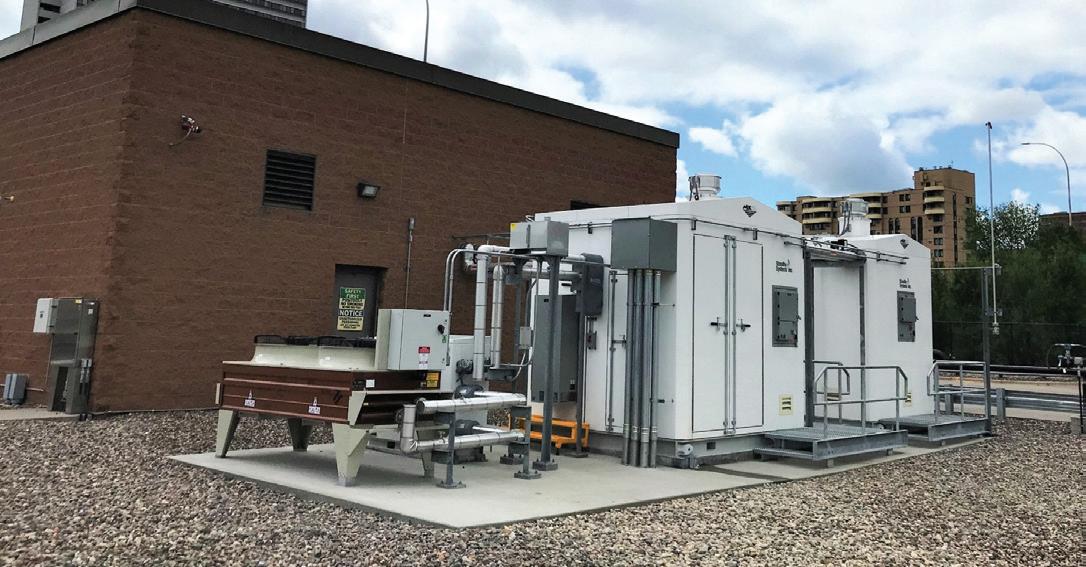
“The cleanest energy is what you don’t have to use in the first place because you’ve been efficient,” Corson said.
Pilot project
Right now, the hydrogen blending project is a pilot project, so it’s on a small scale, according to Corson. He said the electrolyzer is one megawatt. The point of the project is to “learn from direct experience how to produce it, how to integrate it into the natural gas distribution system. It’s an opportunity to educate our stakeholders about the opportunities to scale it up and the opportunity to educate our employees and create excitement about CenterPoint’s commitment to innovation and a clean energy future.”

The
is where the water is filtered and purified, and in the early days when the utility was called Minneapolis Gas Light, it was also used for that purpose for the coal gasification plant. (Photo provided by CenterPoint Energy)
The brick
The location of the green hydrogen project is near the Mississippi River in the downtown area. A small brick building was already there and was previously used to filter water from the coal gas plant years ago, so the utility decided to put it back into use. There are two white sheds by the brick building, which houses the water filtration system. One of the white sheds contains the electrolyzer, and water flows from the brick building into the shed with the electrolyzer where hydrogen and oxygen are separated. The second white shed is where the hydrogen is dried and the pipe is where the hydrogen is blended with natural gas, Corson explained.
The project has been online for the past year and they “haven’t had any major issues. It’s integrated well with the natural gas and we’re looking at the possibility of doing more.”
(Graph provided by CenterPoint Energy)
JUNE 2023 | THE MUNICIPAL 29
CenterPoint Energy green hydrogen plant near downtown Minneapolis.
building
Corson shared Minnesota just passed a new bipartisan state law the Natural Gas Innovation Act which was initiated by CenterPoint. The new regulations open a pathway for utilities like CenterPoint to invest in reducing carbon emissions. He said the utility is finalizing its first innovative five-year plan, which it will submit to the regulators and Minnesota Public Utilities Commission. Its plan is to add several more green hydrogen projects.
“We’re impressed with how the first year worked,” he said.
The utility expects to submit its plan in June. Corson said CenterPoint hopes to do another project where it builds and owns the plant and possibly uses its own solar panel array to power the plant. Officials are also considering working with several industrial facilities to have an on-site green hydrogen plant.
When asked how much carbon emissions are reduced, Corson said the utility had a “modest decrease” in carbon emissions, and as it scales up, it has the potential to reduce carbon emissions much more. Over the course of 10-20 years, there could be a lot of innovation for scaling up, allowing for much higher blending, he surmised.
“This could be comparable to where wind and solar were 20 years ago as emerging technologies,” he said. “They were small scale and more expensive, but as technology developed, the cost came down, and wind and solar are not alternative now, they’re thoroughly in the mainstream of the electric power grid. Green hydrogen has the potential to play a more important role as things develop.”
The expectation for the pilot project is that annually CenterPoint is avoiding about 1,200 tons of CO2 emissions because the green hydrogen is displacing some of the natural gas that otherwise would’ve been emitted. That is equal to the annual use of 140 homes.
Concerns
The main concern to hydrogen blending is the extent to how much green hydrogen can be blended. Corson said research done in Europe suggested the blend could go up to about 20%, but to go beyond that the end-use appliances would need to be modified to accommodate the increased hydrogen, and depending on the pipeline system, accommodations may need to be made to that.

“So there is a limit to how much you can blend,” Corson said. Hydrogen has different chemical properties than methane it’s lighter and smaller so the concern is the tiny molecules could cause weakening or fractures, known as “embrittlement” to the pipeline, especially certain steel pipes. There’s a concern for potential hairline fractures where the hydrogen could more easily leak out. For
the end-use appliances stoves, water heaters and furnaces the flame burns differently.
“It’s also more expensive to produce green hydrogen than conventional natural gas,” he said.
However, the Inflation Reduction Act has a credit provision and tax incentive for producing green hydrogen, but Corson thought the exact rules are still being worked out by the U.S. Treasury.
‘Back to the Future’ Vibes
Corson shared that the new green hydrogen plant has some “Back to the Future” vibes as the location is the same area CenterPoint Energy has used in the past.
“We used to manufacture gas here before, but it was coal gas.”
Prior to the interstate natural gas pipeline’s development, he said, “Up until the 1950s, we had to manufacture our own gas, and it was a very large and very dirty coal gasification plant that operated until the 1960s.”
Since that plant closed, the utility has been getting the gas through the interstate pipelines. He said they cleaned up the land, and now, decades later, they’re manufacturing gas there again.
Another historical fact Corson shared when they manufactured the coal gas, “It had high concentrations 10-40% of hydrogen so it’s like a ‘Back to the Future’ moment.”
The pipe connected to this white shed is where the hydrogen is integrated into the natural gas line in the CenterPoint Energy hydrogen blending pilot project. (Photo provided by CenterPoint Energy)
30 THE MUNICIPAL | JUNE 2023 continued from page 29
The brick building is where the water is filtered before it goes into the white shed in the background, where the electrolyzer zaps the water and separates the hydrogen and the oxygen. The hydrogen continues into the white shed in the foreground, where it is dried and then injected into the natural gas pipeline via the attached pipe. (Photo provided by CenterPoint Energy)
“That will help bring down the cost of green hydrogen,” he said. “The hope and expectation is as technology develops as it gets scaled up and with incentives the cost will come down considerably.”
When asked if the cost was transferred to the consumer, Corson replied for the pilot project it was “so small.”
He said the Natural Gas Innovation Act does allow the cost of investment to be recovered with rate increases, but it establishes a cap on the rates. He said he’s not heard of any concerns about increased rates from consumers at this point.
“It’d be quite modest, and there’s a lot of interest among our customers, the general public and policymakers to find ways to avoid carbon emissions it’s a priority.”
He said some of their larger customers have their own goals to reduce emissions so they’re interested in what CenterPoint is doing.

Southern California and New Jersey
The Municipal could not reach someone from the other two communities doing hydrogen blending projects by phone but obtained press releases.
Southern California Gas has partnered with the University of California Irvine and others to conduct studies on hydrogen blending.
According to a press release dated Sept. 9, 2022, Neil Navin, vice president for clean energy innovation at SoCalGas, stated, “The establishment of a statewide renewable hydrogen blending standard could help scale green hydrogen productions, which in turn could drive down costs for its widespread adoption across the state.”
Navin continued, “A 20% clean hydrogen blend in a system as large as Southern California’s could reduce CO2 emissions in an amount equivalent to removing more than a million passenger vehicles from the road for a year.”
Also in that press release, Jon Preciado, business manager for the Southern California District Council of Laborers, stated, “Hydrogen blending provides real and meaningful opportunities for participation in the clean energy economy for the tens of thousands of highly skilled southern California union members who build, operate and maintain the natural gas utility infrastructure today.”
The press release stated, “More than a dozen pilot projects are currently in progress within SoCalGas.”
The press release from New Jersey Natural Gas spoke about its green hydrogen project in Howell, N.J. Construction started in the summer of 2021, and the project was completed and placed into service in October 2021.
The press release states, “It is the first green hydrogen production project on the East Coast to blend zero carbon hydrogen directly into an existing gas distribution system, directly powering homes and businesses.”

It further states the system offsets 180 U.S. tons of CO2 per year, equivalent to 407,000 miles driven by car, 18,456 gallons of gasoline or 90 tons of coal burned.
Corson of CenterPoint Energy concluded, “We’re proud to be a leader in the natural gas utility sector of exploring this innovation.”
JUNE 2023 | THE MUNICIPAL 31
New York water project highlights pros of communities working together
By BETH ANNE BRINK-COX | The Municipal
We are seeing more and more examples of sharing among communities. In the last few years, some smaller towns moved on to the idea of a shared space for police, fire and EMT; this concept is called a safety center, and it’s a great idea for countless reasons. But that kind of creative cooperation, which benefits so many, needn’t stop there.
In New York, there is an interesting water infrastructure project between the town of Verona and the city of Rome. Verona previously got water from Oneida, but the supply couldn’t keep up with the demand, so they chose Rome as a suitable solution to the problem. Rome’s mayor, Jackie Izzo, and Verona’s town supervisor, Scott Musacchio, outlined and explained this project, making it as clear as, well, good water.
Musacchio began, “I firmly believe in shared services with municipalities who share our similar needs. I believe we should
share our resources to help our neighboring communities. We all see the rhetoric regarding this in every media outlet; however, every elected official in our country, no matter what position they hold, should have a primary focus and duty to serve their residents and constituency.”
Izzo added, “We were doing a water expansion project already, so we just had to make a tweak. The major work was on Verona’s side because they have to expand all the piping.” She further explained, “Verona has to upgrade putting piping in to here in
ABOVE: Verona, N.Y., previously got its water from Oneida, but when the supply couldn’t keep up, it turned to nearby Rome, N.Y., which had the supply to meet demand. (Mahmoud Suhail/Shutterstock.com)
Rome, and they are. We are running a new main to connect everything, and that is almost completed.”

The project is going so well that testing is expected to begin soon. Izzo said, “We are running on schedule actually, maybe even a little ahead!”
Musacchio added, “The town of Verona and the city of Rome, with the assistance of our legislative boards, engineering groups, staffers and many other individuals, were able to make an agreement to purchase this water. Because the city of Rome has the water processing facility and the capacity to serve our needs, this saved the town of Verona millions of dollars.”
32 THE MUNICIPAL | JUNE 2023 Focus on: Water & Energy M
Izzo noted, “Verona is not the only town we serve. We actually have surplus water. We currently sell to Lee, Westmoreland and Whitestown because some part of each town borders Rome. We have a tank with that kind of capacity because we used to have a military base.”
Griffiss Air Force Base closed in 1995. The water filtration plant was meant to service 55,000 to 60,000 people when the base was fully operational.

“So because of the base,” Izzo said, “we have all the plants, all the necessary things to do this. It definitely saved millions of dollars. We have put over $30 million into mandated upgrades. It’s a great example of shared services between municipalities. And it’s really a public health and safety issue, because some properties are on the old Erie Canal, and they’re on wells there. We wanted them to have the ability to get good potable water.”
Musacchio explained financial aspects of this project. “Our water project is being funded by Environmental Facilities Corporation, which is a New York state program. We are also working with Rural Development and several other organizations. The town of Verona has reached out to Senator Chuck Schumer’s office as well, and they have responded and are working with the town of Verona.”
Izzo added, “When the project was announced, Rome became eligible for grant money, and Verona got some as well, plus 0% interest hardship money, too.” This is meant to incentivize municipalities
to improve their drinking water infrastructure, because clean water is a public health and safety issue.
And, Musacchio said, “The EFC and every New York state grant agency review design documentation with the submitted engineering plan (MPR) and the subsequent cost to the resident. The town of Verona, nor any other municipality, can charge more than what is authorized by those funding agencies. In our case, it is $904.00 per year per household, which includes the debt service for 30 years and the usage piece, which is based on an average family unity per their requirements.”
Another added benefit is what this meant for the town of Verona Fire Districts.
“The town of Verona Fire Districts are in favor of having additional fire hydrants, which is included and is one of the primary reasons for our water extension project. Presently, in some cases, our fire companies must import water to fire scenes to fight fires, especially in the hamlet of New London.”
At a time when every second counts, having water immediately available on the scene is absolutely critical. Part of the problem, too, according to Mussachio, was the composition of the ground where hydrants would be, with lots of clay, which causes its own issue.
Musacchio noted, “The town of Verona expects completion of this project in late 2024, pending any other supply chain issues or unpredicted delays. But we are progressing well due to a mild winter.”
JUNE 2023 | THE MUNICIPAL 33
An aerial view shows a reconstructed wooden star fort with bastions and cannons in Rome, N.Y., with the cityscape in the background. (tokar/ Shutterstock.com)
Water is an undeniable necessity. The body can go approximately three days and not much more without it. It’s not just about drinking. Car radiators need it. Everyone needs it for cooking and cleaning. The several industries including the medical field also require a quality source of water.





Musacchio echoed this. “I have lived in the town of Verona the better part of my life, and have lived in hamlets where I have had a dug or drilled well. The water quality, in my experience, in every case was poor, whether it be hard water, which destroys washers, water heaters, dishwashers and clothes, etc. More importantly, the well potability, quality and sustainability to drink the water out of the faucet is suspect in most hamlets. The potability issue can consist of potential nitrates, chloroform or any number of pollutants in our groundwater.

“The town of Verona has been attempting to make this water project happen for 25-plus years. It’s been going on since the late ’90s. I am elated we are finally able to bring clean potable water to our community. This project is the hard work of hundreds of individuals whom I appreciate very much.”



Izzo and Musacchio are genuinely pleased and proud of the col
laboration that’s made all this possible. Next time you draw a glass of water, wash a load of laundry or bathe your baby, you might just feel the same.

PREMIER-MFG.COM | PULLING FOR YOUR SUCCESS | 800.255.5387 ACCESSORIES TRAILER JACKS DRAWBAR EYES HINGE ASSEMBLIES View all products at premier-mfg.com
-
34 THE MUNICIPAL | JUNE 2023 continued from page 33
A B-52 bomber welcomes visitors in the Griffiss Business and Technology Park; it is a nod to the city of Rome’s history and that of the former Griffiss Air Force Base, which closed in 1995. Since the city’s water system was designed to satisfy the needs of the base, it easily welcomed Verona to its system. (Mahmoud Suhail/ Shutterstock.com)
Groundskeepers...







You seed and push snow, mow and grade lanes. You take pride in your work and love a job well done. You treat the ball field as it were your lawn. And there's no stopping your productivity when you're matched with Land Pride products! You achieve great things and you're just our type!







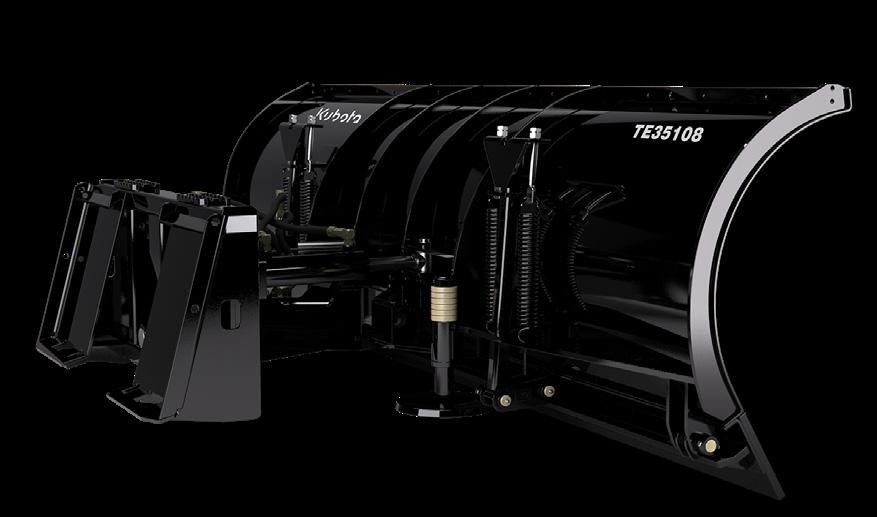


landpride.com
Trusted by more State Police agencies than all other radar brands combined. PMG Bringing Traffic Safety to your Community StreetDynamics.com 1-800-782-5537 JUNE 2023 | THE MUNICIPAL 35
Turbo-Charging the Design Paradigm for Stormwater Quality

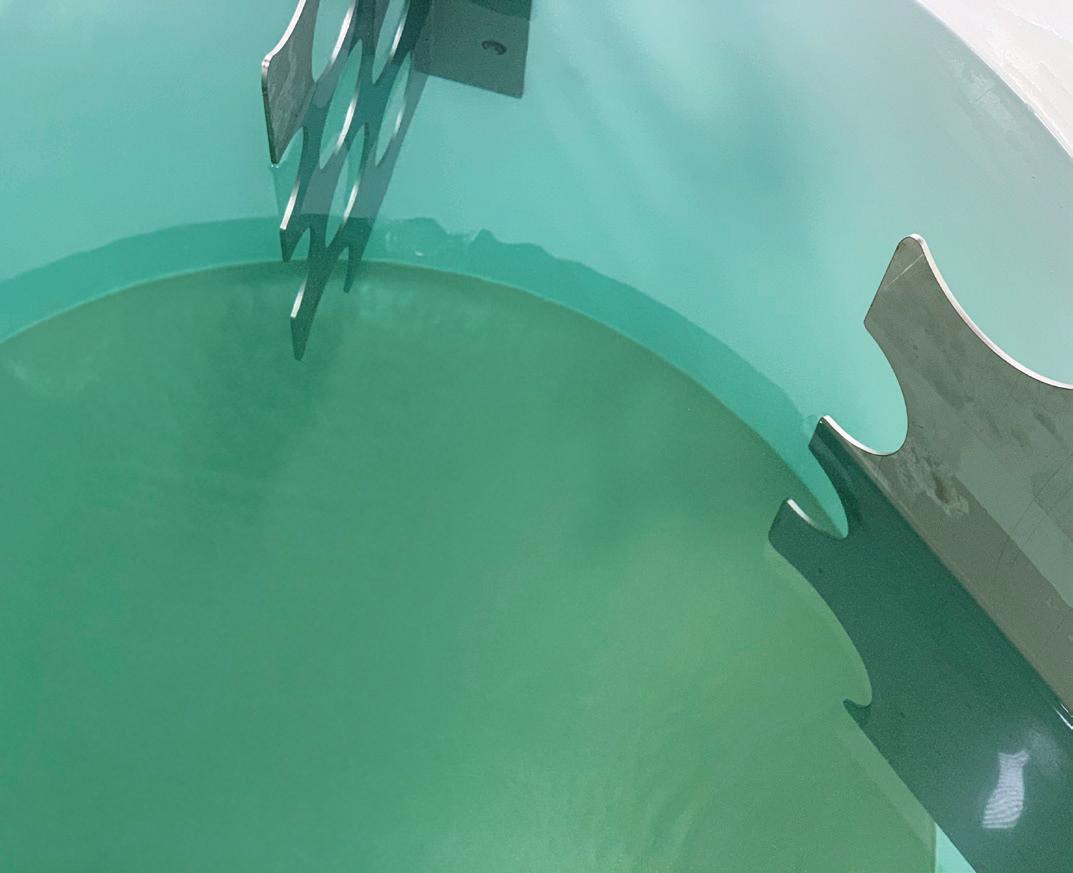
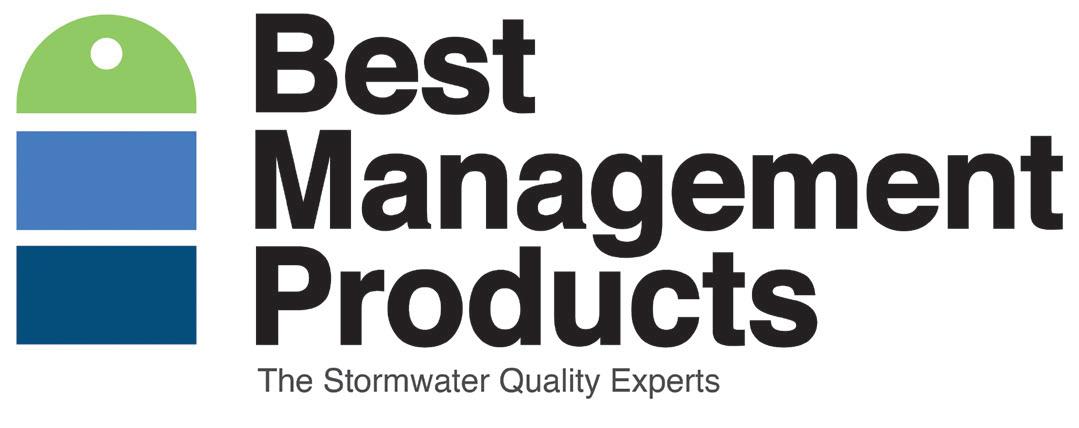 By T. J. MULLEN | President BMP, Inc.
By T. J. MULLEN | President BMP, Inc.

The Turbo Plate® is a simple hydrodynamic device from Best Management Products, Inc. (BMP) that reduces pollution from stormwater discharges. Designed to significantly improve the performance of the SNOUT® water quality hood in an online sump structure, these stainless-steel plates decrease the velocity and turbulence of stormwater flows to increase sediment capture.
To appreciate how such a simple hybrid-baffle device can positively impact solids removal from stormwater, it is helpful to understand a few simple principles of flow dynamics. A common formula used to calculate uniform flow rate is Q=vA, where Q is flow rate (e.g., gallons per minute, liters per second, or cubic feet per second), V is velocity (e.g., feet per second, meters per second), and A is area that the flow moves past, either length times width or based on the diameter (e.g., square feet, square inches, square meters). Therefore, for a given Q (flow rate), if you increase the area that the fluid moves past, you will reduce the velocity as v=Q/A. Using a combination of a solid baffle and perforated baffles this hybrid-baffle technology reduces velocity in two ways. First, flow is re-directed with a solid baffle at the inlet pipe increasing the length of the flow path (it prevents it from going straight through to the exit pipe). Second, the re-directed flow encounters the holes in the perforated baffles, which again increases the length of the surface the flow must move past (think of the flow moving past the length of the circumference of each circular hole). So, by increasing the area the flow moves past, the baffles clearly reduce the velocity which relates to turbulence, an enemy of allowing particles to settle. Simply, if flow is fast, the liquid will have a lot of kinetic energy causing suspended particles to move in a random and chaotic fashion, preventing them from settling.
In an installation, the first Turbo Plate is solid and positioned adjacent to the inlet pipe. The solid plate deflects the flow to one or two perforated plates that improve the separation characteristics of the structure as described above. The calming effect knocks down sediment particles which results in a significant increase in fine solids removal. The flow exits the structure from underneath the SNOUT. The SNOUT with Turbo-Plates showed an 80% sediment removal rate in 3rd party testing at Alden Labs in Holden, MA, for a sediment sample with a 50-1000 micron particle size distribution at 225 gallons per minute.
To hydrodynamically reduce pollution in stormwater in a practical fashion, pollutants should be separated into both floatable and sinkable layers, where they can be collected and later removed during maintenance procedures. To create these layers, reducing velocity and turbulence are desirable benefits of using Turbo Plates with a SNOUT that acts as a skimmer in a sump-style structure. Stormwater engineers typically need to address specific pollutants where sediment, or Total Suspended Solids (TSS) and hydrocarbons are two of the most common targets. In many jurisdictions the use of an “oil-grit separator,” “oil-water separator,” or some other hydrodynamic water quality device is a regular practice to improve water quality. The goal of BMP is to provide engineers with a tool-box of devices that they can use to meet the specific water quality requirements that their projects demand. In addition to SNOUT hoods and Turbo Plates, BMP’s BioSkirts® can be applied to reduce oils and Stainless TrashScreens™ can be used for Full Trash Capture. These components are used in nonproprietary structures made by local concrete precast manufacturers
Advertorial
Turbo plates and SNOUT during flow. (All photos provided by BMP Management Poducts)
36 THE MUNICIPAL | JUNE 2023
Settled solids after flow.
or poured on site by contractors, resulting in significant cost savings. In some cases, these components can be used to retrofit existing sump style structures resulting in the most cost-effective solutions. BMP provides free design recommendations on sizing the structures and performance modeling to predict performance given catchment data and structure dimension inputs.

On a recent project, Greg Schaapveld, PE, Civil Group Leader and Civil Engineer at the Bettendorf, IA office of Shive-Hattery, researched the SNOUT and Turbo Plate on BMP’s website after learning about the company in Stormwater Magazine. Shive-Hattery has been around since 1895 with about 480 employees in 14 locations, where they serve demanding clients throughout the Midwest and Southwest with engineering and architecture services looking for creative solutions. In this case, and industrial client in Iowa needed to expand a parking facility and had to comply with a city requirement to reduce TSS by 80% for the 1.25” design storm. As most of the site is impervious cover connected to an adjacent river by a stormwater conveyance, treatment options were limited to structural devices. As part of the local requirements an oil water separator was already required, but as designed would not meet the TSS reductions.

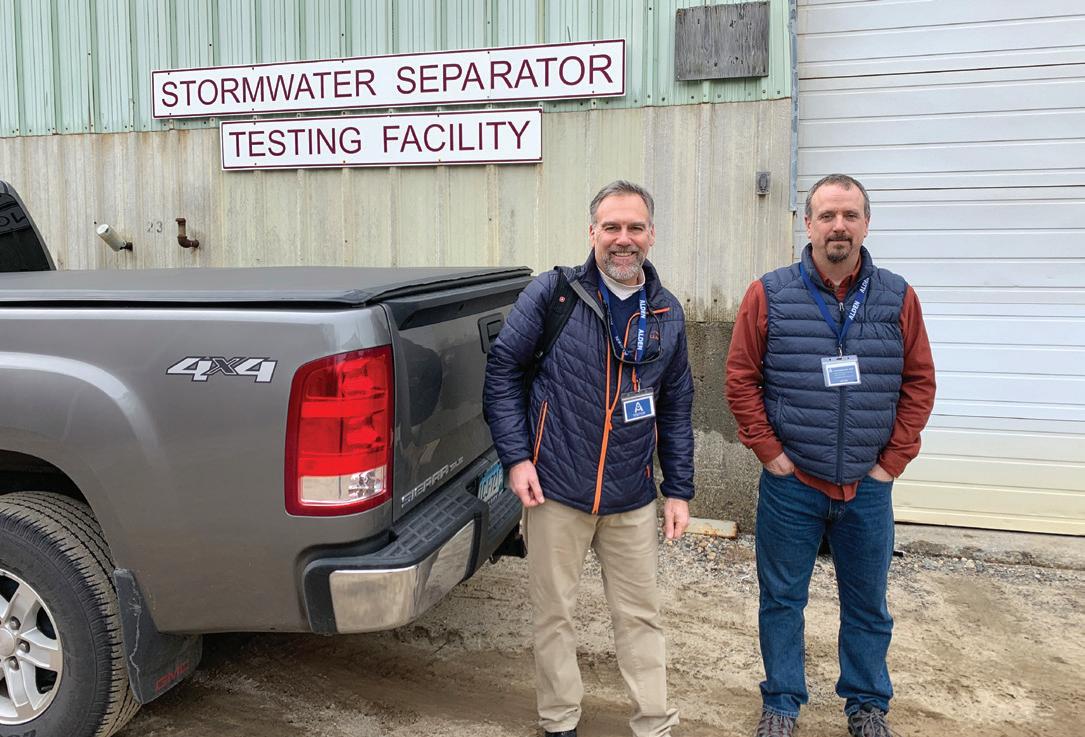

Greg was searching for an option that would meet requirements, while limiting additional expense for the client. He contacted BMP on the company’s web chat service and connected with a company engineer. Greg’s team along with BMP were able to modify the design and retro-fit the structure with SNOUTs, Bio-Skirts and Turbo-Plates that increased the performance to satisfy the local requirements. The two-chamber structure design was modified to make the first chamber a pre-treatment section and the second chamber a polishing chamber. The first chamber with a 15” ID inlet pipe was modified to close the weir on the bottom of the structure and open a 15” orifice creating a 4 foot deep sump. The inlet pipe is fitted with a TP1845S solid Turbo Plate and the sides of the structure each get a TP1890 perforated Turbo Plate. The second chamber receives another 24F SNOUT over the 15” outlet pipe and 2 Bio-Skirts for oils in front of the SNOUT. This design is highly effective as the first structure knocks down sediment and gross-particles then laminarizes the flow into the second structure where the Bio-Skirt attracts hydrocarbons and the second SNOUT further polishes the outflow. Greg said, “working with TJ Mullen at BMP, Inc., couldn’t have been easier. What started as a web chat quickly evolved into storm water quality calculations, installation details and a bill of materials to assist the contractor with costing and in ordering the correct materials.”
Best Management Products, Inc., with more than 100,000 device installations since 1999, works hard to make sure that their clients and customers are all offered personal service for their specific applications. Communicating with customers on their web chat service has been a convenient way to offer timely answers that often result in full-fledged designs and more interaction. BMP’s goal is to design and manufacture affordable products that meet a wide range of stormwater quality treatment requirements. For hydrodynamic separation, Turbo Plates, SNOUTs and Bio-Skirts are suitable for new construction or retrofitting round or rectangular structures with a sump and both an inlet and outlet pipe. Please consult with a BMP application engineer for assistance with design and modeling your project. A BMP application engineer can be reached at 800-504-8008 or at bmpinc.com via the web chat function.
Advertorial
How before solids are injected.
BMP’s TJ Mullin and Matthew White at test facility.
JUNE 2023 | THE MUNICIPAL 37
Engineers reviewing set up.
Madison mayor steps up with a vision
By LAUREN CAGGIANO | The Municipal
Madison, Wis., Mayor Satya Rhodes-Conway is breaking barriers. She’s the second female mayor and the first openly LGBTQ person in that office.
But before taking the helm of “Madtown,” as it’s affectionately called by residents, she served on the city council for six years. In hindsight, Rhodes-Conway said she was quickly steeped in local politics.
“I got into it because I had a friend who ran the cycle before,” she said. “In 2005, I didn’t know anything about local government, but she wanted to be on the city council. I ended up managing her campaign. I had also never
been involved in electoral politics really, at all. But in the process, I got to know a lot more about the city council and about what local government does how immediately impactful local government is on people’s lives.”
These experiences shaped Rhodes-Conway, and an opportunity presented itself to run for a city council seat. At the time, it seemed like a logical progression to take the
ABOVE: In the estimation of Mayor RhodesConway, who has a background in science and is self-taught in the art of politics, there was a binary in the face of the climate change crisis in the United States. Under her tenure, the city has made investments in eco-friendly projects, including ordering high-capacity, zero-emission articulated buses for the city facilitated by Federal Transit Administration funds. (Shutterstock.com)
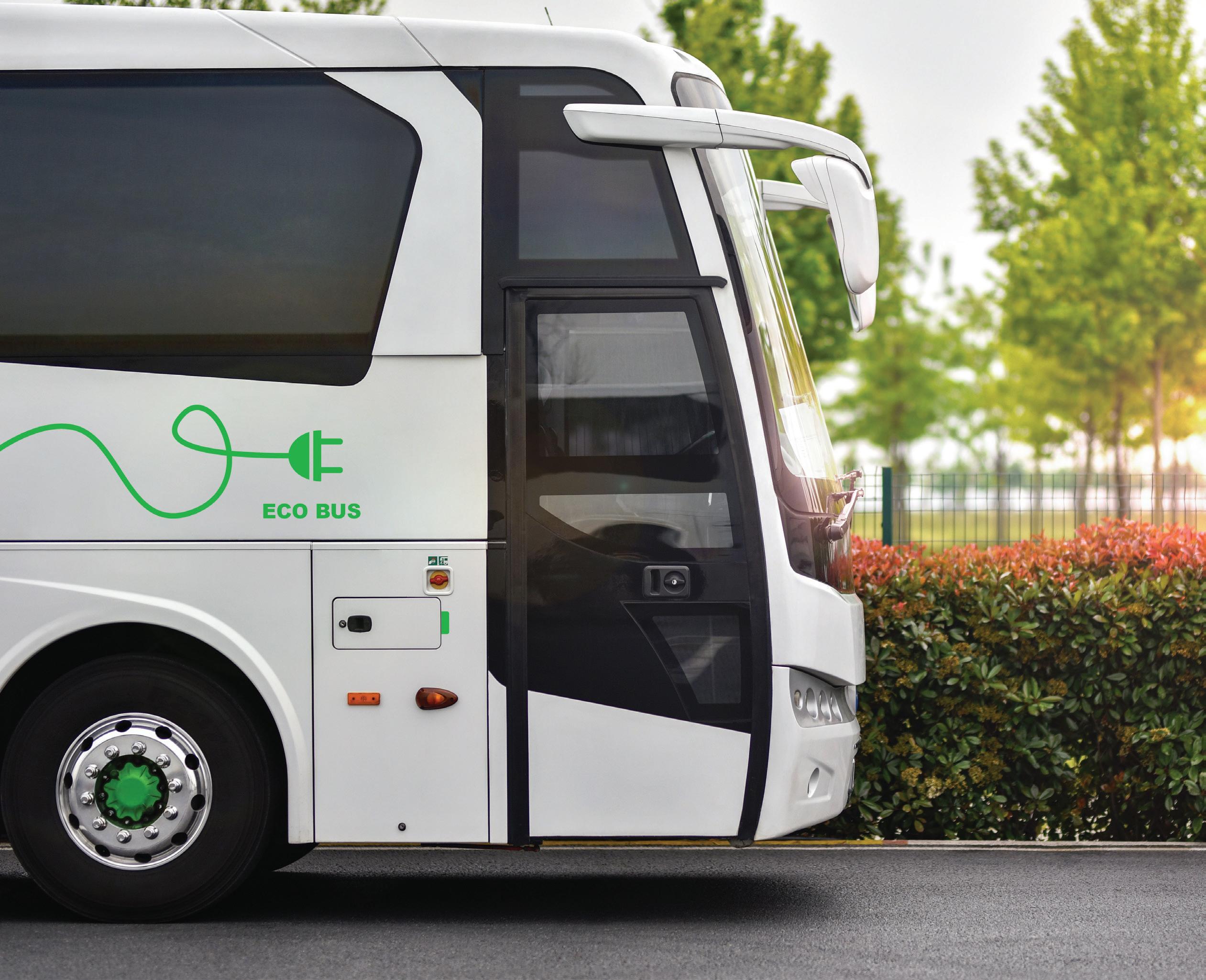
leap from working on local and state policy to being among the people at the table crafting legislation.
In her previous public policy role, she would look at issues like housing markets in the context of their trajectories and
38 THE MUNICIPAL | JUNE 2023 M
Personality Profile
dynamics. That’s when she made the connection: Housing and climate change are inextricably linked, and there was a sense of urgency. It was incumbent on leaders at the local level to commit to change.
“As I was looking at these other cities across the country and studying particularly the trends in their housing markets, I started to be able to see … the early trends in Madison matched up to some of the early trends in other cities. There were issues around affordability, vacancy and displacement.”
Upon her election, Rhodes-Conway committed herself to championing these causes in the mayor’s office. She’s a member of the Climate Mayors network: The group represents 48 states and nearly 60 million Americans and reflects U.S. cities’ commitment to climate progress.
It also helps that she comes from a science background. She approaches problem-solving around sustainability from that lens.
In Rhodes-Conway’s estimation, there was a binary in the face of the climate change crisis in the United States.
In her words, “you can sit on the sidelines, and you can complain. Or you can step up and say, ‘I’m concerned, I have a vision, and I want to do the work.’ So, that’s what I did. Obviously, it worked out.”
Under her tenure, the city has made investments in eco-friendly projects. In January the city ordered high-capacity, zero-emission articulated buses facilitated by Federal Transit Administration funds. The Metro Transit fleet is expected to begin its service in 2024. In addition, the new buses will be equipped with high-power batteries, providing 410 kWh of power to deliver more energy-efficient and
longer-range zero-emission buses. Metro Transit delivers more than 4.6 million annual fixed-route bus and paratransit rides.
Rhodes-Conway said the electric bus order is the biggest contribution in her first four years in the goal of reducing emissions. The development is the context of Madison’s longstanding commitment to helping the planet.
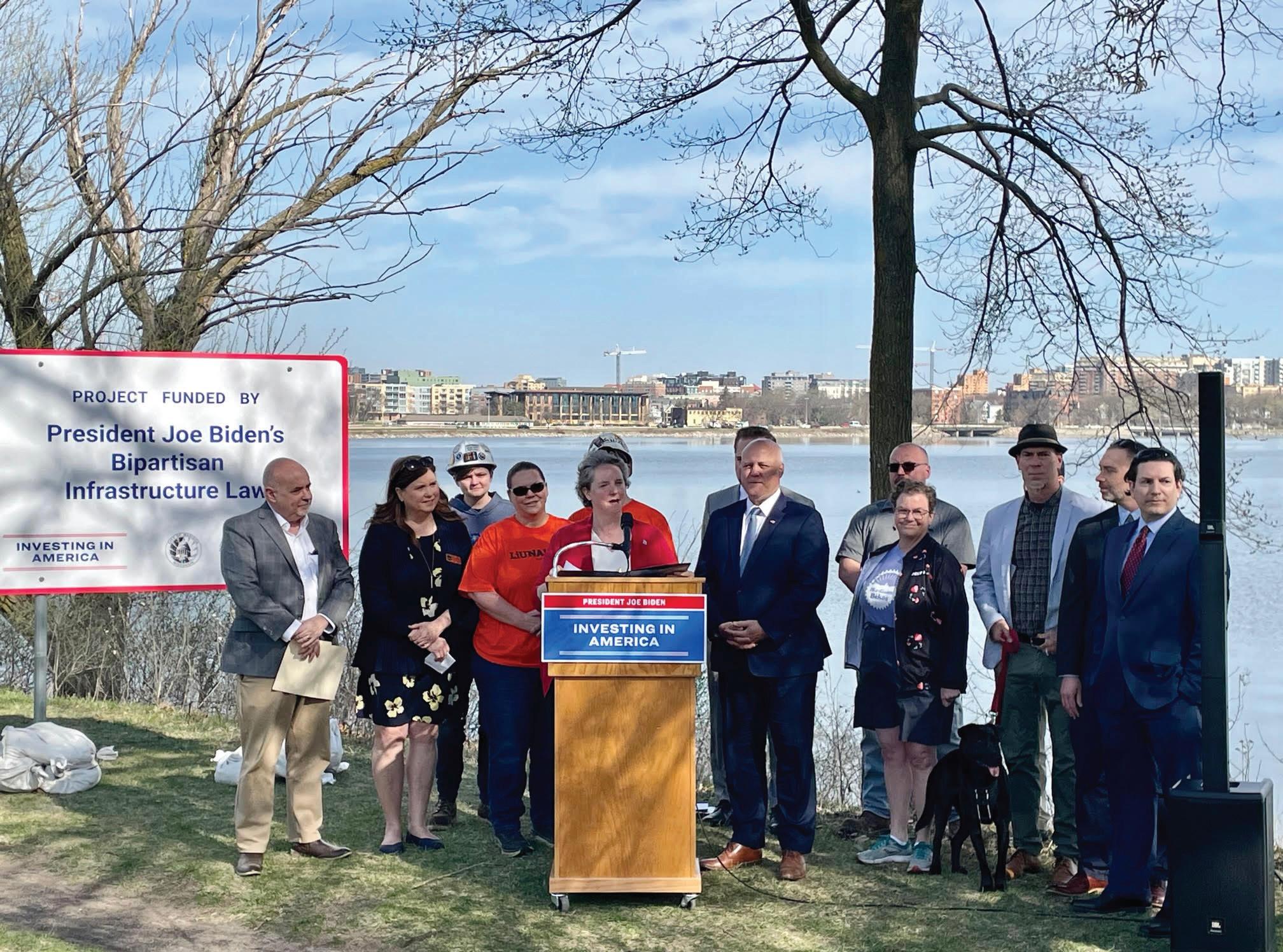
“We have a long history which predates me of putting solar on our city roofs,” she said. “And when we build new buildings, they’re built to a LEED standard. We have many golden and a few Platinum LEED buildings.”
The city’s sustainability-forward approach translates to a sizable investment in terms of economic development. Since 2016, the city’s engineering division has operated the GreenPower program. Funded in part by the American Rescue Plan, the program hires Madison residents as trainees, teaching them how to install and maintain solar panels on government buildings.
Beyond climate change interventions, Rhodes-Conway said that her legacy will be one of solidarity and welcoming the next generation into the fold.
“It’s particularly meaningful when a parent will come up to me and say, ‘Thank you for being out, because my kiddo is questioning or identifies somewhere in the LGBTQ family,’” she said. “It gives me hope that they are going to be fine and successful and that they have plenty of opportunities. It gives them hope that they can see themselves in leadership someday.”
 Mayor Satya Rhodes-Conway serves on various committees and task forces for the U.S. Conference of Mayors and the National League of Cities. (Photo provided by city of Madison, Wis.)
Mayor Satya Rhodes-Conway serves on various committees and task forces for the U.S. Conference of Mayors and the National League of Cities. (Photo provided by city of Madison, Wis.)
JUNE 2023 | THE MUNICIPAL 39
The city of Madison, Wis., government is the latest recipient of a $15 million federal grant to put toward John Nolen Drive Bridge Reconstruction, a generational project with historic funding from the Bipartisan Infrastructure Law. (Photo provided by city of Madison, Wis.)
Marijuana sales benefit Michigan communities
By JULIE YOUNG | The Municipal
In states where the recreational use of marijuana has been legalized, communities are “flying high.” In addition to creating thousands of jobs and small businesses throughout the nation, the legalization and regulation of cannabis-related products has generated billions in tax revenue that is being used to fund a wide range of projects, programs and services.
Making money from Mary Jane
The Michigan Department of Treasury announced Feb. 28 that more than $59.5 million would be distributed among 224 municipalities and counties through the 2018 Michigan Regulation and Taxation of Marijuana Act. In the days that followed, 81 cities, 26 villages, 53 townships and 64 counties received money from the Marijuana Regulation Fund for the 2022 fiscal year. In addition, $69.4 million was
distributed to the school aid fund for K-12 education and the Michigan Transportation Fund, for a total of $198.4 million.
According to Cannabis Regulatory Agency executive director Brian Hanna, the money that makes its way into local coffers through the collected excised tax is an important benefit of the regulated cannabis industry. “The CRA is committed to doing our part in supporting our law-abiding licensees,” he said.
ABOVE: Several downtown development projects, including Riverwalk stairs and lighting, will also be advanced this year in Big Rapids, Mich., thanks to the state’s excise tax on marijuana. (Shutterstock.com)
Communities use the revenue they receive in a variety of ways. This year, Emmet Charter Township in Calhoun County plans to use $600,000 of fund money to cover rising public safety and sewer costs that have created a dent in the township’s general fund. Other communities have spent cannabis tax revenue on street projects, hiring personnel and funding downtown development projects. In Kalamazoo, an MRF windfall from the 2022 fiscal year is helping create a cannabis chamber of commerce to help address the longstanding equity needs for those in the cannabis industry, including microbusinesses and minority-owned ancillary businesses. Cannabis tax income often

40 THE MUNICIPAL | JUNE 2023 M Municipal Management
goes to bolster county and municipal general funds as well.
For the good of the community
In March 2022, the city of Big Rapids, Mich., and Mecosta County split nearly $1.4 million in marijuana excise tax revenue, which was used to fund a wide range of projects. City commission officials in Big Rapids met and agreed that their portion of the money should be spent on visible projects that would allow residents to see the benefit of having marijuana businesses in their community.

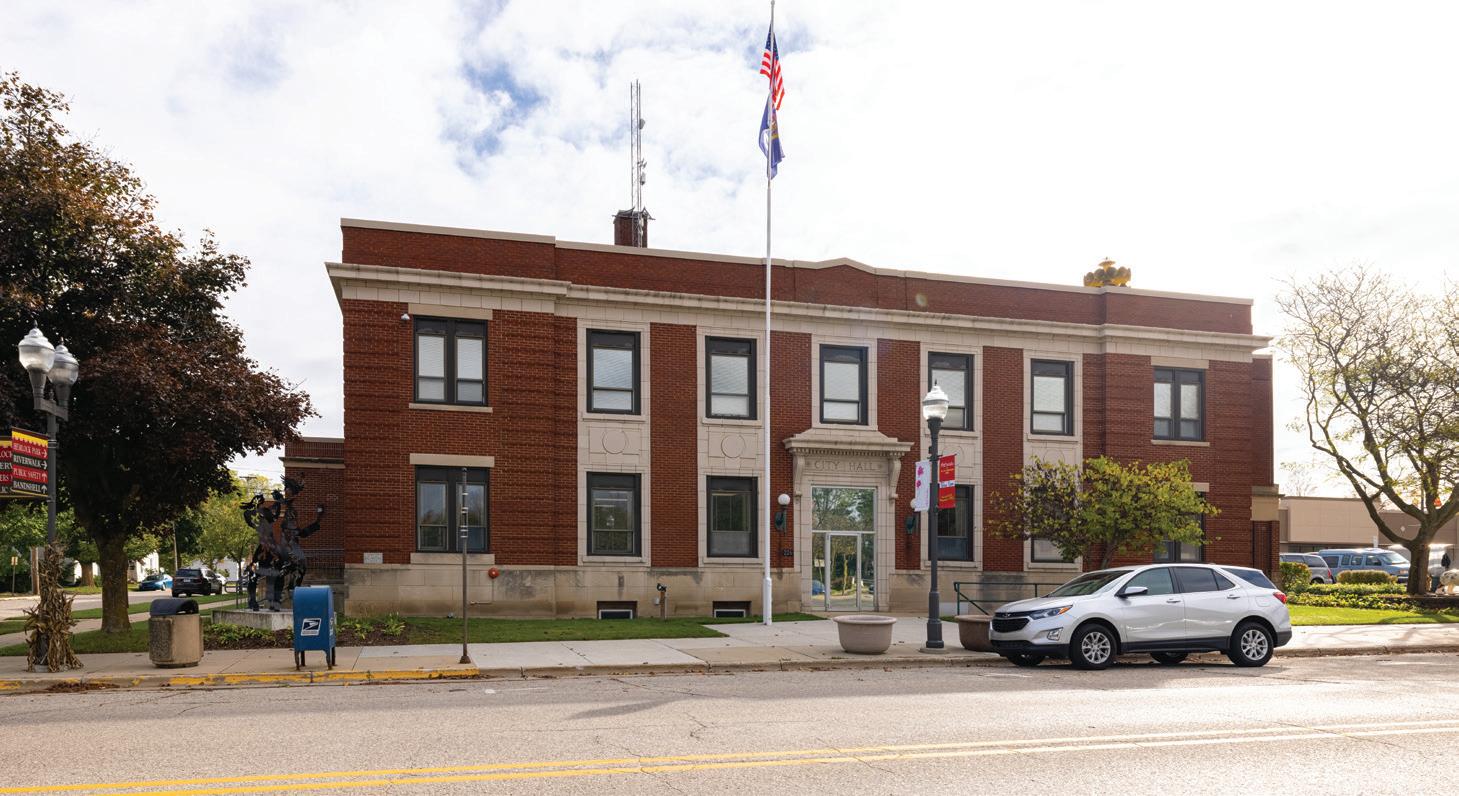
Two months later, the city commission allocated money to its fire and police departments for new equipment; to the city park system for upgrades and improvements; and to the Department of Public Works for downtown development, Riverwalk stairs and lights and parking lot pavement projects, among others.
Paul E. Bullock, Controller/Administrator for Mecosta County, said that the $770,000 received by the county from the marijuana excise tax combined with $8.4 million received from the American Rescue Plan Act would be used on initiatives and projects that would positively impact as many county residents as possible.
“The board of commissioners looked for partnerships within the community that were doing the sort of things the county residents would benefit from and requested proposals from these agencies,” he said.
The chosen projects include the construction of the Dragon Trail, $225,000; the purchase of four generators for parks for a total of $100,000; safety equipment for first responders at a cost of $39,912; Hope House Free Medical Clinic, $50,000; child hunger initiatives, at a cost of $100,000 each year for two years; local food pantries, $100,000; and a marine boat for the Mecosta County Sherriff’s Department, $62,500. “We have not made plans for the 2022 funds yet,” he said.
A wise investment
According to the Marijuana Policy Project, legalizing cannabis has been a worthwhile and wise investment. As of March 2022, participating states reported a combined total of $3.7 billion in cannabis tax revenue.
“Our report is further evidence that ending cannabis prohibition offers
Mecosta County and Big Rapids, Mich., recently split $1.4 million in marijuana excise tax revenue to fund local projects that included the purchase of four generators for parks and safety equipment for first responders, as well as money for initiatives that combat child hunger in Mecosta County. In the 2022 fiscal year, 81 cities, 26 villages, 53 townships and 64 counties across Michigan received money from the Marijuana Regulation Fund for such projects and expenses. (Shutterstock.com)
Big Rapids, Mich., allocated some of its Marijuana Regulation Fund money to upgrade fire and police department equipment and city parks, and invest in downtown development. (Shutterstock.com)
tremendous financial benefits for state governments. The legalization and regulation of cannabis for adults has generated billions of dollars in tax revenue, funded important services and programs at the state level and created thousands of jobs across the country. Meanwhile, the states
that lag behind continue to waste government resources on enforcing archaic cannabis laws that harm far too many Americans,” said Toi Hutchinson, president and CEO of the Marijuana Policy Project.
JUNE 2023 | THE MUNICIPAL 41





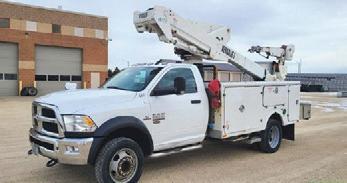

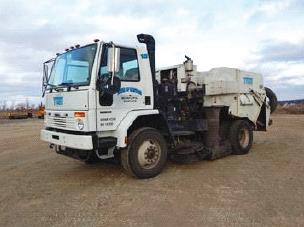



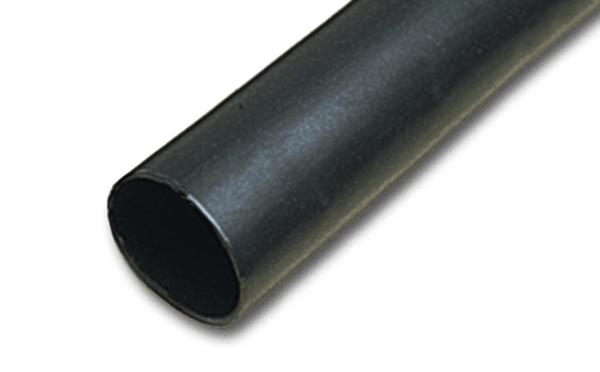










2005 John Deere 644H Articlulated Wheel Loader $56,50000 2016 Dodge 5500 Utility w/Versalift 40’ Bucket $41,10000 1999 John Deere 6410 4WD Tractor $15,80500 2007 Freightliner Tymco Sweeper $18,15000 608-437-2001 or email bid@wisconsinsurplus.com Looking for an easy way to dispose of your unused and surplus items? Try Wisconsinsurplus.com. We will take your descriptions and pictures and sell your items in front of our 136,500+ registered bidders world-wide. We have been an online auction service for over 19+ years specializing in Municipal Equipment. Currently we sell items for businesses in Wisconsin, Illinois, Minnesota and the Upper Peninsula of Michigan. Find out what these other businesses have already found out, that using Wisconsin Surplus is the easiest way to dispose of your unused and surplus items and make money doing it. WE CAN SELL ANYTHING YOU HAVE Give us a call or drop us an email to find out how we can help you. Recent Success Stories Call us to be our next success story Superior Heat Shrink Technology from DSG Canusa View stock, check pricing, or place your next order at: www.waytekwire.com/DSGCanusa DERAY® Splicemelt 4:1 • Adhesive lined crosslinked polyolefin • High shrink ratio to fit varying splice configurations CPX Multi-purpose 2:1 • 2:1 shrink ratio • Resistant to common fluids and solvents CPA Dual Wall 3:1 • Adhesive lined for superior sealing against water, moisture or other contaminants DSG Canusa Heat Shrink Tubing is a cost-effective solution for protecting, insulating, and sealing automotive wire, electrical connectors, and mechanical switch gear parts. It can be used for submersible and burial applications in various markets including electronics, electrical, and automotive. Join the Municipal Community Join the thousands of government leaders who subscribe to The Municipal magazine and newsletter. Sign up to get the best in information, products, services and equipment for America’s municipalities delivered straight to your mailbox and inbox. The Premier MAGAZINE FOR AMERICA’S MUNICIPALITIES 866-580-1138 42 THE MUNICIPAL | JUNE 2023
Combination Sewer Cleaner
BIG CLEAN. IN A COMPACT PACKAGE.

When there’s a dirty job to be done, trust the iMPACT sewer cleaner to do it without washing quality and safety down the drain. All this power, control and ease of operation is backed by our commitment to keep you up and running with operator training and Vactor’s unmatched service and support.
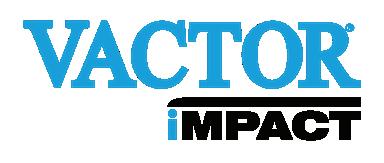

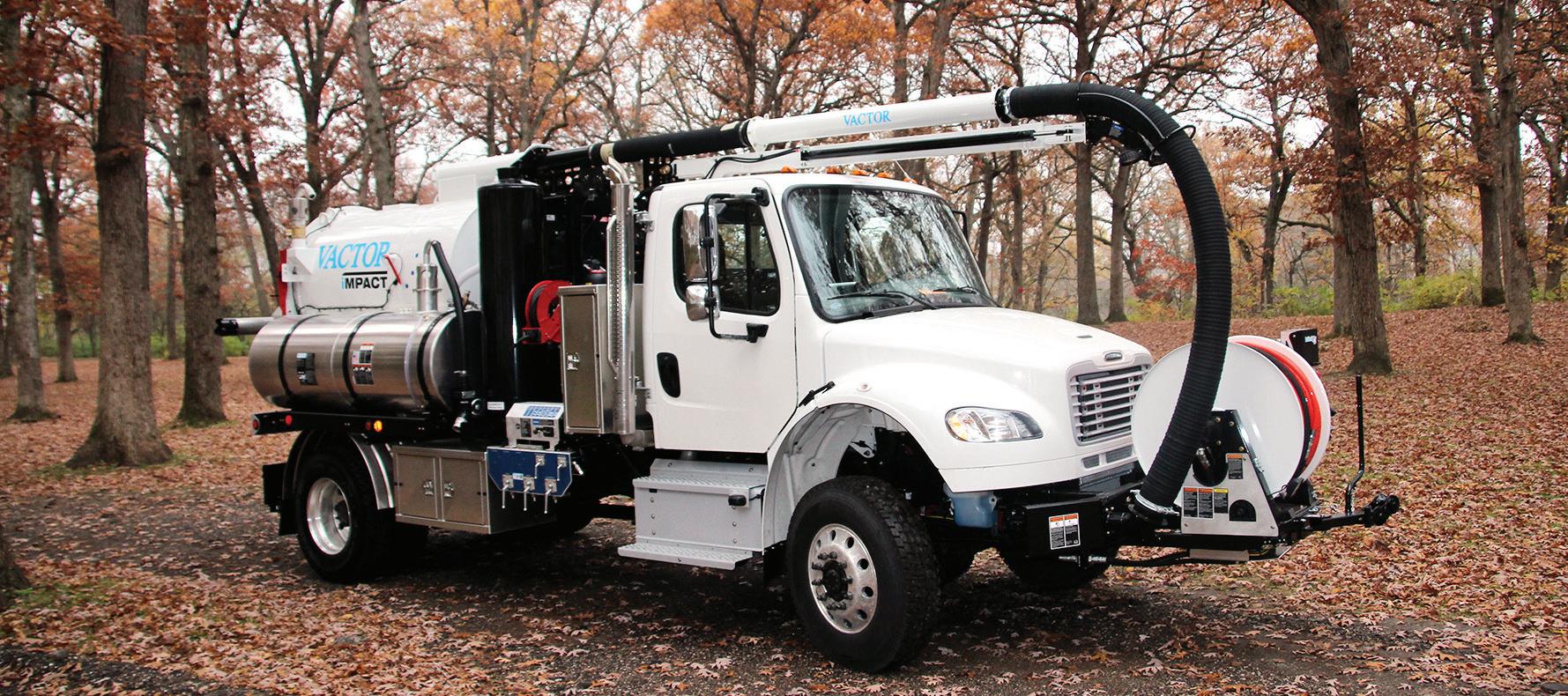
Have questions on equipment or applications? ASK OUR EXPERTS

2023 05 Vactor half page - Municipal.indd 1 5/1/23 2:27 PM JUNE 2023 | THE MUNICIPAL 43
Perseverance reconnects coastal town to its legacy
By JENNIFER BARTON | The Municipal
Along the U.S.-Canadian border rests Blaine, Wash., a small town with a population of around 6,000 residents. Of its 8.43 square miles 2.80 are water, according to the U.S. Census Bureau. It is a prime location for migratory birds and waterfowl to roost, which brings in tourists who come to birdwatch. However, decades of debris and erosion have taken their toll on the waterfront, and city officials have been working for years to counter their effects and preserve and protect the coastline at Marine Park.
Blaine began as a seaport, becoming industrialized with sawmills and a salmon cannery and crisscrossed with roads and wharfs elevated above the water on pylons. Relics from the old shingle mills were dumped along the shoreline as industrial waste; more recently, a 1960s and ’70s road project saw concrete chunks dumped along the coastline, twisted rebar protruding from the pieces and creating a dangerous eyesore. Officials knew something had to be done to reclaim the land.
Alex Wenger, economic development and tourism coordinator for the city of Blaine, became part of the team working to restore the beachhead when he began working there in 2004.
“I’ve really seen this project come and go,” he stated, noting that even his father, as regional shoreline planner for the state, had been
involved in it years ago. “It’s almost a legacy project for me.”
In Blaine, Wenger explained, “We were experiencing significant coastal erosion; this approximately 50-year-old broken shoreline was failing. That left compromised, exposed soil. Basically, the dirt banks were eroding much more quickly in the last couple years.”
This erosion caused pieces of the city’s shoreline trail to wash away. Park benches became undercut and needed to be removed, and critical infrastructure on the land needed to be protected, including a $35 million stateof-the-art water reclamation facility that cleans sewer water and reuses it as irrigation water.
Work began in 2009 with a feasibility study. From there, it was a matter of securing grants and making plans for a park that residents could safely enjoy.
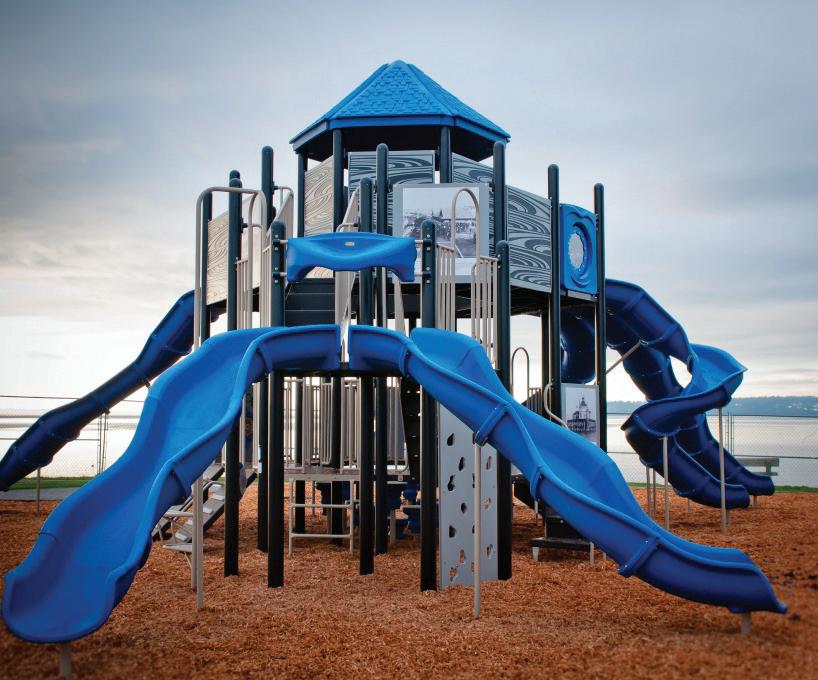
The rubble was cleared in 2014 so construction could begin. Wenger reported that the city was able to obtain a large grant from the Washington State Recreation and Conservation Office called the Aquatic Lands Enhancement Account. Money from the ALEA is allotted to communities in Washington that seek to protect and enhance coastal lands.
Blaine city officials took a two-pronged approach toward fixing the problem: stabilize
 Marine Park’s playground received a boost during the city of Blaine, Wash.’s, project to preserve and protect its coastline at the park. This lighthouse playground nods to the city’s nautical past. (Photo provided by the city of Blaine)
Marine Park’s playground received a boost during the city of Blaine, Wash.’s, project to preserve and protect its coastline at the park. This lighthouse playground nods to the city’s nautical past. (Photo provided by the city of Blaine)
44 THE MUNICIPAL | JUNE 2023 M Parks & Environmental Services
the shoreline and create a habitat for people “to go down to the water’s edge and experience a beach-like environment,” Wenger said.
Before the project, since community of Blaine is separated from the waterfront by railroad tracks, Marine Park provided the main waterfront access for citizens and tourists, particularly birdwatchers. Now, a portion of the park is set aside to protect the habitats of those birds and waterfowl, while other parts are designated for human enjoyment.
Among the popular attractions are the playgrounds. One has a nautical design, intended



to resemble the Lady Washington, a local ship that sails to coastal cities like Blaine; another resembles the historic lighthouse that once graced Semiahmoo Spit but was torn down in 1944. The sides of the lighthouse playset are graced with panels upon which are printed historic photographs, captioned by a local historian “as a way to capture Blaine’s history, maritime past in the playground itself,” Wenger said.
He proudly reported that the community pulled together to make the park a reality. Ninety thousand dollars of the funding required
to build it came through private donations by the citizens. Bronze sea life plaques placed at the park recognize donors who made the construction possible.
To improve and beautify the shoreline, planners trucked in all-natural materials tons of boulders and beach sand to create a look consistent with the rocky beaches of the Pacific Northwest. The final phase of the Marine Park project will be completed later this year, when “pocket beaches” will be put in, allowing water access for people who wish to wade or even swim in the cool waters of Semiahmoo Bay.
Wenger calls Marine Park “the crown jewel of the city’s park system.” In addition to the playgrounds and walking trail, it offers free Wi-Fi, quality restrooms and spectacular views. “It’s a favorite walking spot for locals to go down and look at wildlife … the sunsets are amazing looking toward the west. So, whether it’s your first stop in America or your last on your way out, it’s a really great spot to go.”
For other cities looking to undertake similar projects, Wenger had this advice: “It’s all about having a plan.” If officials can create a plan that convinces the community of the need and possibilities, that can lead to conceptual drawings, securing permits, pursuing more grants, “and before you know it, you’ve got yourself a permitted, funded project. It might take a few years or a decade to accomplish, but start small and just keep going.”
Though there will always be more work to accomplish, the citizens of Blaine, Washington, will benefit from the years of perseverance shown by community leaders like Wenger and their commitment to keeping Blaine’s shoreline stable and beautiful.
Children will get to play pirates when they visit Marine Park. (Photo provided by the city of Blaine)
Through its efforts to ease erosion, residents and visitors will be able to enjoy Marine Park and its shoreline for generations to come. (Photo provided by the city of Blaine)
JUNE 2023 | THE MUNICIPAL 45
Marine Park provides the main waterfront access for citizens and tourists, particularly birdwatchers. (Photo provided by the city of Blaine)
Small town acts to capitalize on new-found fame
By DANI MESSICK | The Municipal
A small city in the spotlight is working on a plan to maintain tourism draws after the camera crews dissipate.
In 2016, husband and wife team Ben and Erin Napier premiered the HGTV restoration and revitalization show “Home Town.” It garnered a nationwide audience and engendered two short-lived spin-offs. In the beginning, the location of their hometown where the renovations took place wasn’t highly advertised, but now that it is, the city of Laurel, Miss., is making changes to the way it integrates tourism into its hopes of long-term future growth.
“We are reaping great benefits from ‘Home Town’ being filmed in Laurel,” Mayor Johnny Magee said. “We realized that one day it’s going to come to an end, and we wanted to be able to have something to keep people coming to Laurel.”

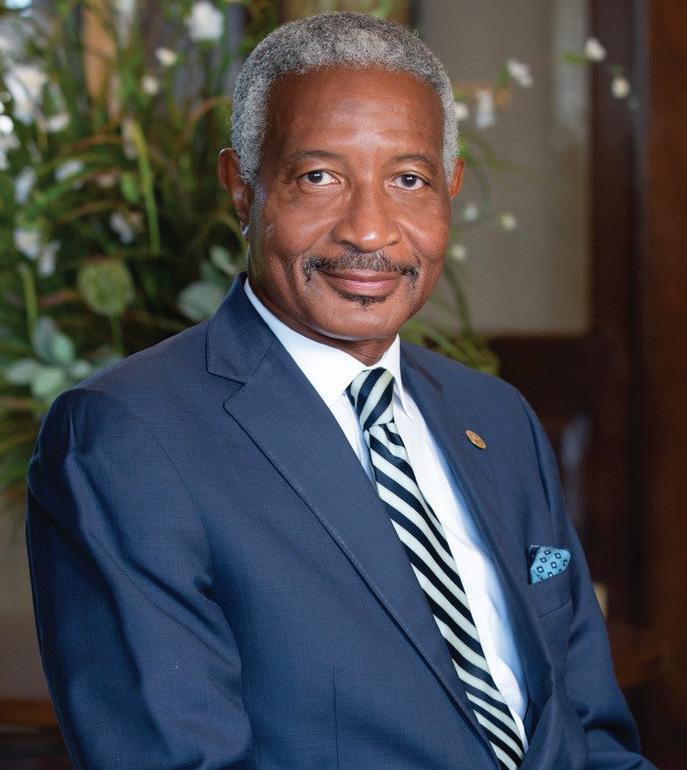
The first thing Magee and the city council realized was that in order to keep people
coming, they needed to promote the municipality of 20,000.
Laurel’s Tourism Committee consists of six volunteer members with voting power and two advisory members one from the economic development authority and the other from the Main Street committee. The committee, Magee said, has been one of the most important parts in the process of growing tourism in the city.
“Find a group of people that agree on the major goal. Our major goal was to continue to bring people to our city,” Magee said. “And find a small group, because groups that are too large don’t tend to function very well. Find some people who really want to see something happen in their city and put them together. We’re still amazed at all the ideas that come up.”
To finance the budding tourism industry, they went to the Mississippi Legislature to ask for an increased tax on hotels and short-term rental properties. The state already had a tax on hotels and restaurants that is used to pay off recreational debts like a sports complex, but it offered them more than the additional
46 THE MUNICIPAL | JUNE 2023 M Municipal Management
Mayor Johnny Magee
Citizens and visitors gather every year in February for the annual Magnolia State Bank Chili Cookoff in downtown Laurel, Miss. The event takes place on the second Saturday. All entries are cooked on-site and judged by a team of professionals: The chili is then sold to the public in bottomless bowls, handcrafted by a local potter. (Provided by city of Laurel, Miss.)
3% they asked for if they could get 60% of citizens in the state to vote in favor. They did, at a whopping 73%.
“The good thing about it is, it’s paid for by people outside of the community,” Magee said. “If you don’t stay in a hotel or short-term rental, then you don’t pay this tax, so the people in the city don’t have to pay it. We just reap the benefits of the people who come to the city.”
Before the show started, Laurel didn’t have a lot of short-term rentals. “We had bed-and-breakfasts, but now we’ve got a lot of Airbnbs,” Magee said.
The city set a budget of $250,000 for the year. Since November, when the tax was implemented, it has averaged $25,000 in income from it per month.
“We’re still pushing the ‘Home Town’ show, but we’re also adding things as we go along to keep people coming,” Magee said. So far, billboards have been purchased for the northern and western state lines, and Laurel has begun offering sponsorships for events that bring visitors to town overnight.
Funds from the tax go to the city, but the city council gives the tourism committee decision-making power on how to spend the money. Sponsorships are capped at $2,500, with stipulations that the event should draw people to the city and encourage them to spend the night
in the city. One of the events the city opted to sponsor was April’s Downtown Crawfest.


In addition, real estate and sales taxes are increasing for the city due to people moving into the community.
“When people come to Laurel, they find there are a lot of genuine and friendly people here,” Magee said. “There are a lot of people who love this city and who would do anything for it, and people from outside of the community soon find that out. They will ask, ‘Are Ben and Erin as nice as they act like on the show?’ It’s hard to believe sometimes, but they really are that down-to-earth kind of people who would sit on the porch, drink tea and wave at you as you walk by. That’s the culture of the city of Laurel.”
The tourism committee has begun rebranding the city with all-new identifiable and uniform logos.
“We have a national audience, and when the show is aired, our branding will appear on the show,” Magee said. In recent years, even the city’s water tower has been presented to viewers.
“We have a lot of tour busses coming now because of the show, but we want to hopefully be able to draw people because of something besides the show,” Magee said. “We have one of the best historic districts in the southeast. The timber barons who came to Laurel in the 1800s to cut a lot of yellow pine that was in the area, they brought their culture and their education, and it made a difference in Laurel. The homes that they built are a part of our great and well-known historic districts.”
At one point, Laurel was known as the Yellow Pine Capital of the World.
“We are able to put that out there for people to see because of these tourism dollars that we’re able to generate,” Magee said.
JUNE 2023 | THE MUNICIPAL 47
Thousands gather on Front Street for the annual Community Bank Downtown Crawfest in Laurel, Miss. The event takes place every April on Front Street and includes live music, beverages and team competitions. (Provided by city of Laurel, Miss.)
There’s dedication to community composting in Decorah
By BETH ANNE BRINK-COX | The Municipal
Mostly when people think about composting, it’s a pile in the backyard. It seems pretty simple. In many ways, it is. But the state of Iowa, long known for its beautiful farms, has taken that a big step further with the help of a grant from the U.S. Department of Agriculture. The community pilot project in Decorah is one of 45 cooperative agreements that support innovative, scalable plans to reduce and divert food waste from landfills.
The city of Decorah, however, had an interest in composting before the state received the grant. In January, Decorah’s Sustainability Commission endorsed a project that made high-quality home composting bins at reduced prices available for Winnishiek County; but the $106,000 grant was also very welcome. Additionally, $85,000 came from the USDA, and $21,000 was a local match from the city’s Sustainability Fund.
The grant program requires a local match of 20%, explained Jeremy Bril, city engineer and street commissioner for Decorah. “The USDA provides 80% of the total eligible project costs. Our matching funds came from the city of Decorah. And, specifically, we will use revenues generated from our electric franchise fee to cover the city’s portion of the project. We do not expect additional funds will be needed for this pilot project, but if any of the components of the project are implemented on a permanent basis, additional funds will be necessary. Depending on the extent of the funds needed for permanent projects, we would expect the electric franchise fee would then be the primary funding source for the city.”
Why would any city want to do such a project? Well, why wouldn’t it? Food waste in landfills or any other trash receptacles can cause all kinds of problems such as animals tearing into and scattering trash; a greater fly population, which increases the risk of disease;

and those are just a few of the possible issues. If not in a landfill, where then would the food waste go? What’s the best way to deal with it? And what defines ‘best’?
Enter the Sustainability Committee
Bril said, “A few years ago, our city council appointed a Sustainability Committee, and this committee recently worked with city residents and local leaders to develop a Sustainability Plan for the city. One goal within that plan is to reduce the amount of waste that is sent to our local landfill. Since food waste is often a significant portion of solid waste sent to the landfill, increasing the amount of community composting was listed as one of the plan’s objectives.
“We were made aware of this USDA funding opportunity from Jennifer Trent, with the Iowa Waste Reduction Center, after attending a training on community composting. The pilot program seemed like a perfect opportunity for us to try out some larger scale composting efforts that could potentially be implemented in our community. After being made aware of the funding opportunity we assembled a team of community partners to work on developing a grant application. The program is a competitive grant that requires an application be submitted to the USDA for consideration.”
48 THE MUNICIPAL | JUNE 2023 M Waste & Recycling
The pilot project laid out multiple objectives, including increasing community home composting, working to incorporate food waste into the city’s compost process, and improving the city’s compost facility to develop a higher quality compost. There are various partners on board as well, including the Decorah Sustainability Commission, Winneshiek County Conservation, Luther College, Oneota Community Food Co-op and the Iowa Waste Reduction Center. In the end, the community will see local food systems and food recovery networks improved as the food waste reduction solutions benefit farmers and communities.
As so many other city and state projects everywhere learned, the pandemic and resulting quarantine changed projected dates, both of beginning and completion.
“We found out at the beginning of February 2022 that we were awarded the grant, but we were actually able to start the implementation in April of this year,” said Bril. Nothing will stop them now, though, he went on to say. “Our pilot project has three primary objectives. We want to utilize education and outreach to increase residential composting, and provide supplies for home composting. We plan to partner with local businesses and institutions to collect food waste, to incorporate into the city’s existing compost production process. We intend to modify the city’s existing composting process to produce a higher quality of compost for distribution to area producers.
So far, they have been working on Objective No. 1.
“We have held four different trainings for residents over the past month. At each training, residents learn about the benefits of home composting and how to develop a productive compost pile. Because of the USDA funding, we have been able to give each resident who
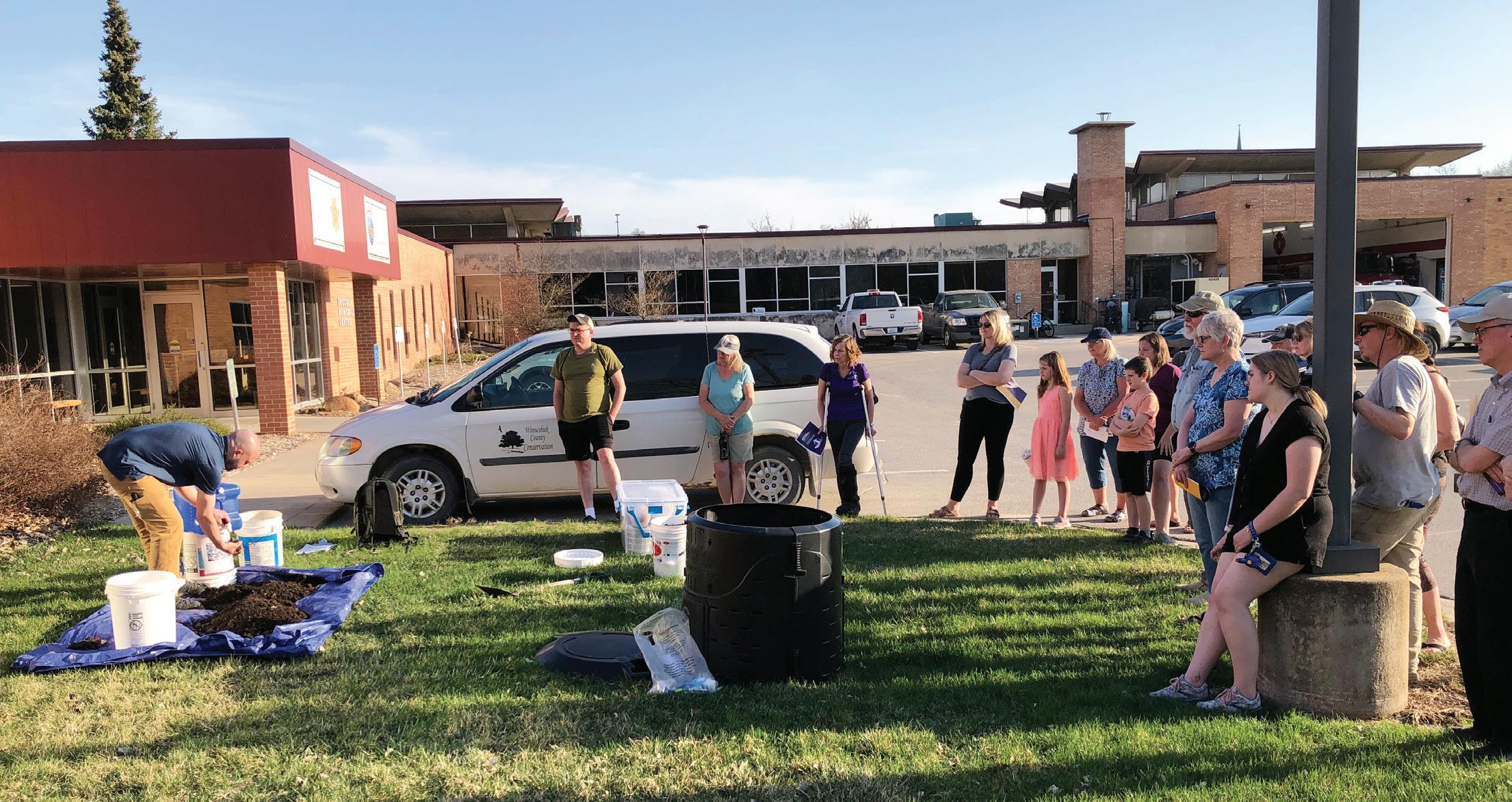
attends the training a free backyard composter for them to install at their homes. Since our project really just started, we have not otherwise been impacted significantly by the pandemic.”
Composting and green projects
Although the plan is a big project, one might expect the community response to be a good one in a farm community. Bril enthusiastically noted that this was the case in Decorah. “The community response has been great. We have purposefully kept our training sessions small, about 20 people each, so it feels more personal. But each one has been at near capacity. We are expecting to have to schedule more trainings than initially planned, based on the interest we are receiving thus far.”
He added that he wouldn’t go so far to say that it is commonplace, but that Decorah probably has a higher-than-average percentage of home composters already. Based on the participation they see in the county’s recycling program, this is not overly surprising, he said. However, the county landfill still receives a lot of food waste on a daily basis, so there are still opportunities to get more folks involved in home composting.
“We are hoping a successful pilot project will allow us to implement community composting at a larger scale, as we think it will be very well received by the community. The biggest and most immediate benefit will be a reduction in solid waste delivered to our landfill. Based on a statewide study, it is estimated that our community of just over 7,500 people contributes over 8,000 pounds of food waste per day to the landfill. If the majority of residents were able to compost even a portion of that, we could see major reductions in a relatively short period of time.
JUNE 2023 | THE MUNICIPAL 49
Representatives from the Iowa Waste Reduction Center show residents how to create the perfect recipe that will ensure a high-quality compost. There has to be a proper mix of all the right components for best results. (Provided by the city of Decorah)
And it’s no surprise the city also has several other green projects underway.” said Bril.
“We recently installed solar panels on one of our city buildings, and in an empty lot to our city campground. We have received funding to install several stormwater best management practices, such as a constructed wetland, bioretention cell, oxbow wetlands, infiltration basin, and native prairie plants. Just last summer, we installed the first two city-owned electric vehicle chargers downtown, and recently received a grant to install another EV charger in our business district. Our wastewater treatment plant will be completing a major renovation this year, with the primary goal of improving energy efficiency by replacing outdated equipment.”
There are city gardens, too, although they have not yet been incorporated them into the community composting project because the focus to date, according to Bril, has been developing partnerships with larger producers such as grocery stores, schools, restaurants and so on. “But I imagine if we can demonstrate a successful pilot project, the city gardens will certainly be part of a permanent program in the future.”
“I would strongly encourage any community who is thinking about a community composting project to consider this USDA funding opportunity first,” said Bril. “It is a great opportunity for a ‘test run’ on what could work in their community. A pilot project will allow you to make connections with community partners, identify logistical challenges, and obtain feedback from residents. I would start by checking out the
USDA’s Composting and Food Waste reduction website https:// www.usda.gov/topics/urban/coop-agreements to learn about the grant opportunity, and also see a list of the projects that have been awarded over the past few years.”
CITY DECISION-MAKERS LOVE THE MUNICIPAL

Being a new mayor in a small borough in Somerset Borough, Pennsylvania, I read your magazine for the first time and found your articles of importance and helpful reading (April 2023).

Focus on Public Safety, “How prepared is your city for an active shooter incident,” electric squad car and the advertiser index information were full of statistical areas for Borough Managers.
Thank you for sending us a copy of your magazine and please keep us on your mailing list. We also thank you for any additional information you may wish to share.
With respect and appreciation,
Mayor, Frederic A. Rosemeyer
A representative from Winneshiek County Conservation leads a training on the benefits of composting at home. (Provided by the city of Decorah)
50 THE MUNICIPAL | JUNE 2023 continued from page 49

JUNE 2023 | THE MUNICIPAL 51
Cedar Rapids, Iowa, to incorporate 20 roundabouts to improve public safety
By STACI REAFSNYDER | The Municipal

European countries have implemented the use of roundabouts for traffic safety for several years. Now, the city of Cedar Rapids, Iowa, is following suit, having turned to roundabouts to improve public safety and traffic operations.
“There are several reasons that go into why roundabouts are used. Traffic flow, safety and cost-benefit analysis are taken into consideration along with the environment and location of the area,” Cedar Rapids senior traffic engineer Ron Griffith said.
The city website — cedar-rapids.org — reports that roundabouts reduce fatalities by more than 90%, while also seeing a 35% reduction in crashes. The traffic structure also eliminates head-on crashes and rightangle crashes, among other things. The site
adds roundabouts can improve traffic flow, especially during peak driving hours.
“Studies have shown that roundabouts help to reduce the need for all cars to stop at an intersection, which has also been shown to have a positive effect on air quality,” Griffith said. “Reduced speeds, fewer conflict points and the right-only approach to entering the roundabout all contribute to improved safety.”
“Traffic flow has improved and the severity of crashes has decreased,” Assistant
52 THE MUNICIPAL | JUNE 2023 M Streets, Highways & Bridges
Director for Public Works Brenna Fall said. “Roundabouts also improve pedestrian comfort and safety, as many are designed so that a person only needs to cross one lane of traffic at a time.”
According to the Iowa Department of Transportation, there are approximately 60 roundabout intersections across the state. Eleven of these roundabouts have been constructed in Cedar Rapids, a project that started in 2017. The city now plans to add nine more in the next two years, bringing the total of roundabouts to 20.
According to Griffith, the city has received traffic safety grants for several roundabout projects from the Iowa Department of Transportation. Capital Improvement Project funds are then used to supplement the safety funding, Griffith said.
Though roundabouts have been a common use in European countries, they are not common in the United States. According to Fall, the concept of roundabouts is still fairly new in Iowa and a lot of drivers reported they are uncomfortable with how a roundabout is supposed to operate.

“During project development, the city hosts public meetings, where renderings, brochures and videos are shared, and residents can ask questions about how roundabouts work,” Fall said.
When constructing these roundabouts, the city follows guidance provided by NCHRP Report 672 “Roundabouts: An Informational Guide, Second Edition” published by the Federal Highway Administration, Griffith stated.

According to Fall, the city’s experience has been mostly positive surrounding roundabouts, although it has taken time and effort to implement the first roundabout projects.
“Several years ago, there was not much support from elected officials, and the first roundabout projects proposed were not immediately approved,” Fall said. “As other communities in the area began to build them, the city continued to propose roundabouts for specific intersections where the most benefit could be realized.”
Fall stated the city has seen the most success at locations where traffic could be removed, an all-way stop condition could be avoided and near elementary and intermediate schools. Fall attributes the city’s
outreach and education to the success of the roundabouts.
“When implementing a roundabout near a school, the outreach is especially focused on parents, bus drivers and school faculty and staff,” Fall said.
According to Fall, Cedar Rapids has provided the renderings, videos and other information on how to use roundabouts via the city’s website. These make education more easily accessible for drivers who are unaware of exactly how a roundabout works.
“In addition to public meetings, the city conducts traffic studies to determine if a roundabout would be the best solution for the designated area,” Fall said.
Fall said, when it comes to implementing roundabouts into traffic flow, start with single-lane ones, as they are easier to understand and maneuver.
“Take the time to help educate drivers on how to safely drive in a roundabout to allow them to get more acclimated to the change,” Fall said.
On the Web
View NCHRP Report 672 “Roundabouts: An Informational Guide, Second Edition” at https://nacto.org/docs/usdg/nchrprpt672.pdf.
The Sixth Street SW project included pavement reconstruction and a roundabout, new sidewalk and trail, additional turn lanes, utility upgrades, and new trees and plantings. It was completed in 2022. (Photo provided by the city of Cedar Rapids)
JUNE 2023 | THE MUNICIPAL 53
A semi-trailer truck navigates the Williams Boulevard roundabout in Cedar Rapids, Iowa. (Photo provided by the city of Cedar Rapids)
San Antonio partnership helps business owners recuperate from double whammy
By BETH ANNE BRINK-COX | The Municipal
COVID-19 impacted every aspect of life and lifestyles, not to mention businesses. Despite valiant efforts, many stores, restaurants and services didn’t survive. But San Antonio, Texas, is using a new program — COVID-19/Construction Recovery Grants — to provide economic relief to business owners impacted by ongoing construction, as well as those still recovering from the pandemic.
It was a two-fold problem that required extra thinking and planning. No one expected immediate, overnight recovery. But San Antonio was ready for such a challenge.
Rory Dew, marketing and communications manager for the San Antonio Economic Development Department, explained how everything got started.
“Small businesses are an integral part of what makes San Antonio, San Antonio. The city is committed to supporting current and aspiring business owners through a number of strategic initiatives that have included relief efforts due to the pandemic.
“In June 2022, San Antonio City Council approved the American Rescue Plan Act small business implementation plan, which utilized $30.95 million in ARPA funds toward transformational investments in access to capital, capacity building, ecosystem enhancements, geographic placemaking and localism. The CCRG program is the
ABOVE: A favorite way to see San Antonio, Texas, is along the waterways. Kayaking, canoeing, and paddle boating and boarding are all very popular attractions, especially during the post-quarantine recovery. (Photo provided by the city of San Antonio)

second COVID-related grant funding initiative sponsored by the city’s EDD as a part of the Implementation Plan. In 2022, the department awarded $15.6 million through the COVID Impact Grants as the city continued to recover from the impacts of the pandemic. Businesses located in identified construction project areas were eligible for an additional $10,000 of grant funding through this program.”
Altogether, the city has invested $82 million in small businesses since the pandemic began.
Dew elaborated, “The city partnered with LiftFund to administer this latest program. The application required businesses located in or adjacent to identified long-term, city-initiated construction project corridors to submit paperwork demonstrating a reduction in net profit of $10,000 or more from fiscal year 2021 to fiscal year 2022.”
Public outreach for the program included advertising buys, pitching local media sources, direct mail, block walking and the activation
M Streets, Highways & Bridges
54 THE MUNICIPAL | JUNE 2023
of such resources as the city’s Business Development Organization partners and city council district offices.
The application process for this grant officially opened on Feb. 13 and closed on Feb. 28. Awardee notifications and funding began in mid-March. “All funds are scheduled to be disbursed by early June,” Dew said.
Prior to the announcement of the grant there were some business owners along North St. Mary’s Street who felt the continuing construction was affecting their locations. He said this program had helped the issue, although it hasn’t alleviated all problems.
“The construction project on North St. Mary’s has taken longer to complete than initially expected due to unforeseen utility issues and an expansion of its scope to include pedestrian lighting and landscaping. With completion imminent, business owners on North St. Mary’s will soon enjoy the benefits of these upgrades, including more reliable infrastructure and a safer, more walkable environment for patrons of this region, which is largely populated by restaurants, bars and nightclubs,” Dew said. “North St. Mary’s was an eligible construction zone for the COVID/Construction Grants Program, and we expect to see businesses from that corridor awarded funding through the program.”
But, he noted, “while COVID and construction projects have created some challenges for all San Antonians, the response to this program and others has been largely positive. Where constituents and business owners have shared their concerns, city staff and council members have been receptive to feedback and worked diligently to tackle challenges, while simultaneously developing strategies aimed at mitigating them, and moving forward.”
Many cities and their businesses learned this was the best way to recover after the pandemic shutdown: Do what you can with what you have, and then problem-solve the rest. Grants and other forms of funding have been the backbone of this kind of work.
The program was not first come, first served. Dew said all submitted applications were scored on a series of four criteria, including reduction of Net Revenue from 2021 to 2022, percentage of U.S. Small Business Administration Size Standard Equity, Equity Atlas Score, and construction project duration. Applications with the highest scores were reviewed, approved, notified and funded first, if they were eligible.
Dew mentioned that LiftFund was an equally important part of the equation. “LiftFund has been a valued partner in several of our initiatives, and that has included all of the pandemic-related grant programs since 2020. They are also a partner with the city on the Zero Interest Loan Program, which allocated $500,000 to buy down interests on loans this fiscal year.”
LiftFund was founded in San Antonio in 1994 by Janie Barrera. It is one of the largest micro- and small business lenders in the United States. The company has provided loans to enterprises of all sizes across many industries: approximately 25,000 loans totaling more than $439 million, with a 96% repayment rate.
It started out as a company with just three employees. Today, there are more than 100 employees in 15 different states who provide much more than money, offering training and other forms of assistance that can help small businesses grow more quickly. It’s easy to see how such a partnership could do much in tandem with the CCRG.
San Antonio is ever-growing: This year alone, there are plans for major projects including parks, markets, housing, a performance

center and adjacent dog park, and a new Women and Children’s Hospital, not to mention ongoing construction, repair and upkeep on freeways and other roads. With funding made available in every way possible and planners, designers and work crew rolling up their sleeves in cooperation, there’s no end in sight. The pandemic is mostly over, but the recovery cannot and will not be stopped, setting a hopeful example for municipalities across the country.
 The waterways are beautiful when lit up at night, but they also remain stunning in full sunlight. (Photo provided by the city of San Antonio)
The waterways are beautiful when lit up at night, but they also remain stunning in full sunlight. (Photo provided by the city of San Antonio)
JUNE 2023 | THE MUNICIPAL 55
The flame sculpture overlooks one area where the CCRG program was considerably used. When businesses benefit, so do the owners and patrons. (Photo provided by the city of San Antonio)
M Conference Calendar
To list your upcoming conference or seminar in The Municipal at no charge, call (800) 733-4111, ext. 2307, or email the information to swright@the-papers.com.
JUNE
June 2-5 91st Annual Meeting U.S. Conference of Mayors
Columbus Hilton Downtown, Columbus, Ohio
https://www.usmayors.org/ meetings/
June 4-7 70th EUFMC Williamsburg Lodge & Conference Center, Williamsburg, Va. www.eufmc.com
June 4-7 Prima 23
Long Beach Convention Center, Long Beach, Calif. https://conference.primacentral. org/special%20events.cfm
June 5-7 Colorado Association of Chiefs of Police Annual Conference
Estes Park, Colo. https://www.colochiefs.org/
June 5-7 Safety 2023 San Antonio, Texas
https://safety.assp.org/
June 6-8 OVFA Annual Conference Roseburg, Ore. https://ovfa.org/conference/ registration/
June 6-9 NYWEA-NEWEA Joint Spring Technical Conference Saratoga Hilton, Saratoga Springs, N.Y. https://www.nywea.org/ SitePages/Education-Outreach/ Events-Conferences.aspx
June 7-9 Texas TAMIO 2023 Annual Conference
Live! By Loews, Arlington, Texas https://texastamio.org/2022annual-conference-information/
June 7-9 Local Government Reimagined Conference Long Beach, Calif.
https://icma.org/events
June 7-9 6th Annual North American Active Assailant Conference
Woodside Bible Church – Troy Campus, Troy, Mich. https://shop.centermassinc. com/info/naaac-conferenceinfo-speakers
June 8-11 Texas City Management Association Annual Conference
Marriott Dallas Allen Hotel & Convention Center, Allen, Texas https://tcma.org/329/TCMAAnnual-Conference
June 8-11 International Hazardous Materials Response Teams IAFC The Hilton of Baltimore, Baltimore, Md.
https://www.iafc.org/events
June 9-14 Texas SFFMA 147th Annual Training Conference & Convention McAllen, Texas https://www.sffmatx.org/
June 11-14 Colorado Municipal League 2023 Annual Conference Gaylord Rockies, Aurora, Colo. https://www.cml.org/ conference
June 11-14 2023 IPMI Parking & Mobility Conference& Expo Fort Worth Convention Center, Fort Worth, Texas
https://www.parking-mobility. org/ipmi-meetings-events/ ipmi2023/
June 11-14 ACE 23 The World’s Premier Water Conference Toronto, Canada
https://www.awwa.org/ace/
June 14-15 ORWA Equipment Expo & Training Stillwater, Okla. https://orwa.org/expo/
June 14-16 Arkansas Municipal League 89th Hybrid Convention Little Rock Statehouse Convention Center, Little Rock, Ark.
https://www.arml.org/newsevents/meetingregistrations
June 14-16 Indiana Volunteer Firefighters Association Convention
Courtyard Muncie At Horizon Convention Center, Muncie, Ind. https://ivfa.org/convention/
June 14-17 Fire Rescue Improvement Conference Myrtle Beach, S.C. https://scsfaevents.org/firerescue/
June 18-21 Michigan Water Environment Association 98th Annual Conference
Amway Grand Plaza Hotel & DeVos Place, Grand Rapids, Mich.
https://www.mi-wea.org/
June 19-23 NFPA Conference & Expo Mandalay Bay Convention Center, Las Vegas, Nev. https://www.nfpa.org/ conference
June 20-23 AWC Annual Conference
Spokane Convention Center, Spokane, Wash.
https://wacities.org/eventseducation/conferences/awcannual-conference
June 21-23 League of Minnesota Cities Annual Conference
Duluth Entertainment Convention Center, Duluth, Minn.
https://www.lmc.org/learningevents/events/league-events/
June 21-24 114th Annual Utah State Firefighter’s Association Convention
Bryce Canyon City, Utah
https://www.fireassociation. com/upcoming-events/
June 25-28 MML Summer Conference & Expo Ocean City, Md.
http://www.mdmunicipal. org/375/Summer-Conference
June 25-28 Michigan Association of Chiefs of Police Summer Professional Development Conference Shanty Creek Resort, Bellaire, Mich.
https://www. michiganpolicechiefs.org/
June 25-28 Colorado Municipal League 101st Annual Convention
Gaylord Rockies, Aurora, Colo. https://www.cml.org/ conference
56 THE MUNICIPAL | JUNE 2023












FIRETEC.COM/WP/SELL-MY-FDS-TRUCK FIRETEC USED APPARATUS SALES WWW.FIRETEC.COM • EMAIL: FIRETEC@FIRETEC.COM We sell directly, FD to FD, for Fair Market Value! 800-FIRETEC (347-3832) TEXT: 802-431-6033 It’s Easier Than Ever to List your Department’s Good Used Fire Truck! Join the Municipal Community Sign up to get the best in information, products, services and equipment for America’s municipalities delivered straight to your mailbox and inbox. The Premier MAGAZINE FOR AMERICA’S MUNICIPALITIES 866-580-1138 PRODUCTS, INC. Signs, Tags & Markers Everlast Indestructible Signs The Only Sign System to be UL Tested to 40 Years ... NO CHANGE! 1-800-221-1311 www.TechProducts.com Manufacturer of snow poles, storm drain markers, marking flags and signs (330) 325-2966 www.EdinburgAuction.com WE ACCEPT CONSIGNMENTS! CONSIGNMENTS! Next auction Wednesday June 14 6:30pm We facilitate opportunity and growth by supporting communities with their everyday buying and selling needs through online auctions. No matter what you need to buy or sell, our friendly and knowledgeable team of experts will help you find auction solutions that work for you! Heavy Equipment Construction Landscaping Snow Removal Transportation and More! Please email katie@edinburgauction.com JUNE 2023 | THE MUNICIPAL 57 Product Spotlight
PFAS is lining up to be the biggest and costliest environmental hazard in history
By MICHAEL DIGIANNANTONIO | Attorney at SL Environmental Law
The Environmental Protection Agency (EPA) released the first-ever proposed regulations for per- and polyfluoroalkyl substances (PFAS). The proposed maximum contaminant levels (MCLs) for PFOA and PFOS are 4 parts per trillion (ppt), and the EPA is proposing that PFNA, PFHxS, PFBS and GenX be regulated to limit any mixture containing one or more of the substances using a hazard index calculation. The proposed rule is expected to be finalized near the end of 2023 or early 2024.
Public water systems across the country will have to monitor for these six chemicals and respond if concentrations are found in excess of these levels by either taking the contaminated sources out of service or treating the contaminated sources. PFAS is so ubiquitous that water systems that test for it tend to find it this has proven to be the case in states that already have PFAS MCLs, such as California, Massachusetts and New York. As water providers across the nation discover these contaminants in relative unison, the demand for treatment technologies and infrastructure upgrades is likely to rise.
“We haven’t really seen a contaminant with such a combination of dangerous attributes before. It is scientifically established that exposure is dangerous even at very low concentrations. The contaminant is incredibly widespread because it has been used in so many different products for decades and PFAS does not break down naturally. The new MCLs
are a clear indication of these facts,” said Ken Sansone, partner at SL Environmental Law Group.
If a chemical is toxic, persistent and bioaccumulates, meaning the body’s tissue absorbs the substance faster than it can be eliminated, it fits the criteria for a hazardous substance. The EPA has already announced a proposed designation for two of the most common PFAS compounds, PFOA and PFOS as hazardous substances under the Comprehensive Environmental Response, Compensation and Liability Act (CERCLA). Handling and disposing of hazardous substances is costly and requires a certain level of expertise.
On Jan. 6, 2023, the EPA announced the automatic addition of nine (PFAS) to the Toxics Release Inventory (TRI) list, another indication that the regulatory process for these chemicals is ramping up and there is more to come. UCMR 4 already required testing for a number of PFAS substances, but under
ABOVE: PFAS used in firefighting foam has resulted in water contamination. (Peter Togel/Shutterstock.com)

UCMR 5, 29 more PFAS substances will need to be tested. This means that water providers who tested last time and didn’t have contamination above the level may now find other compounds at higher levels.
Who is responsible for the cleanup?
Unless the manufacturers responsible for this pollution are held accountable for the cleanup, the billions of dollars to remove PFAS will be a burden borne by water systems and their ratepayers, who have also likely been exposed to the toxic chemical. There is ample evidence that PFAS polluters have been aware for decades of the dangers of PFAS, resulting in a number of plaintiffs filing suits seeking to hold these companies accountable for the harm caused by these chemicals. This includes water providers seeking to recover the expenses of removing these chemicals from public water supplies. Many of these water providers, who have played no role in producing the PFAS contaminating their water, believe that they should not face the burden of removing these contaminants from their water supply alone. Nor do they think such costs should be incurred by their ratepayers.
Due to the large number of lawsuits that have been filed against PFAS manufacturers in recent years, with respect to water
58 THE MUNICIPAL | JUNE 2023 Company Profile M
contamination caused AFFF containing PFAS, such as those used previously to extinguish fires, many of the cases have been transferred to a multidistrict litigation (MDL). MDLs are used to coordinate complex litigation filed in multiple federal district courts by similar parties. By consolidating the discovery and pretrial motions, both sides save time and money. The new MCLs are likely to give rise to more water providers joining the MDL that is being heard in the United States District Court for the District of South Carolina. The first trial, or “bellwether,” is scheduled to go to trial in June 2023. Bellwethers serve as test cases, helping the parties assess liability theories, defenses and damages. If these early cases yield favorable results for the plaintiffs, the larger pool of plaintiffs can often proceed forward more efficiently, and sometimes create a “domino effect” of settlements or court judgments.
Given the progress that has already been made, this MDL may provide water providers their best chance of recovering the costs of PFAS cleanup. There is still time to file a claim and join this MDL. It is a streamlined legal process and, if water providers chose a law firm that works on contingency, fees are only paid if their case receives a successful outcome.
Protect yourself against rising treatment cost and tightening regulation
While 3M recently announced that it will stop making PFAS by 2025, an indication that legal efforts to expose the harm of these chemicals has finally caught up to the company, many water providers still must contend with how to remedy contamination that has already occurred. Even if a water provider does not exceed MCL limits today, that may change as these chemicals are still making their way through the environment.
“Water providers in states with no PFAS regulatory standards are likely to find PFAS, and even if they are below the MCL now, they are not necessarily in the clear as federal regulation can often trigger stronger regulation at the state level. Water providers need to consider the statute of limitations that varies from jurisdiction to jurisdiction, but generally begins once the discovery of the contaminants has been identified in the water supply or when the provider takes some action in response to the awareness of the contaminant. Claims brought after the statute of limitations has
To keep up with federal regulations, municipalities will need to invest in new treatment facilities. Water providers can file a claim to get ahead of the statute of limitations, even if they detect these chemicals below the MCL. (Shutterstock.com)
U.S. public water systems will have to monitor for six per- and polyfluoroalkyl substances and respond if concentrations are found in excess of set levels by either taking the contaminated sources out of service or treating the contaminated sources. (APChanel/ Shutterstock.com)


run out cannot be brought, no matter how valid or valuable they are. Therefore, there is no benefit to waiting,” said Sansone.
Water providers can file a claim to get ahead of the statute of limitations, even if they detect these chemicals below the MCL. This gives a time period of protection if things change and investment in new treatment facilities is required.
“We have never had a contaminant so dangerous and yet so widely used for such a long period of time there is no
comparison. Unfortunately, this is shaping up to be an expensive environmental disaster of historic proportion, both in terms of total cost of damages and number of people exposed to it. It is going to take everyone’s participation, including the polluters, to right this wrong,” concluded Sansone.
For more information, visit www.slenvironment.com or call (415) 348-8300.
JUNE 2023 | THE MUNICIPAL 59




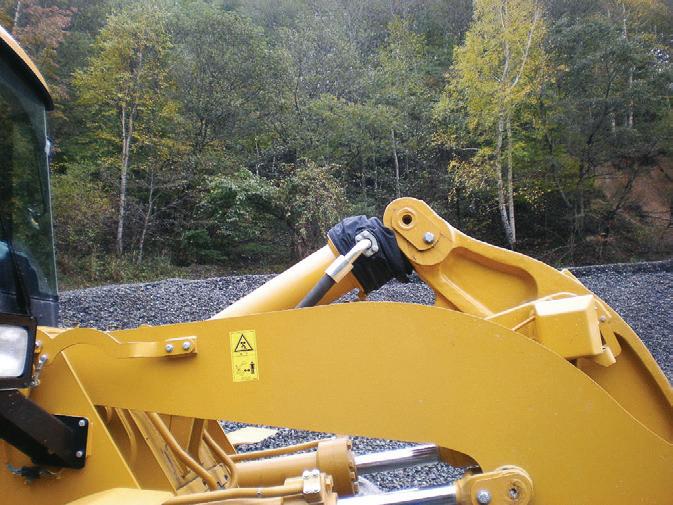
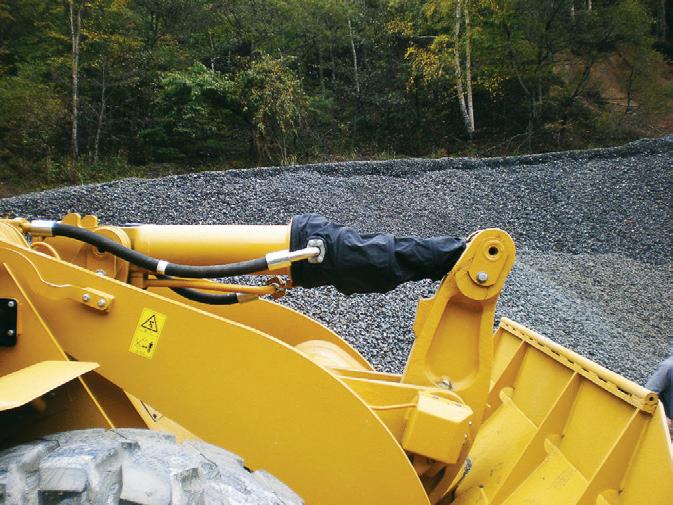




SAVE THIS AD WILL: • Minimize/Eliminate rod scoring • Extend the life of cylinder seals • Protects cylinders from the elements • Prevent pitting due to chemical washers • Reduce particle contamination of hydraulic systems • Minimize dings and dents associated with falling debris has proven effective in Recycling, Construction, Mining, Rock Quarries, Waste Management, Refineries and Wood Products industries the never ending cycle of cylinder repairs Exclusively manufactured by: Fluid Control Services, Inc. | 1.800.683.5189 1155 Allgood Road • Suite 15 Marietta, Georgia 30062 | Fax: 770.509.5832 FOR WHEN YOU’RE TIRED OF REPAIRING/REPLACING CYLINDERS Toll Free 1.800.407.4674 | Americanshoring.com New England Area 238 E. Cherry Street Shrewsbury, MA 01545 MidAtlantic Area 506 Pulaski Highway Joppa, MD 21085 Factory & Corporate Office 207 Lake Street (Route 32) Newburgh, NY 12550 Steel and Aluminum Trench Shoring Manufacturer S A L E S R E N T A L S R E P A I R S 60 THE MUNICIPAL | JUNE 2023

JUNE 2023 | THE MUNICIPAL 61
ISUZU Executive Director of Marketing Brian
Tabel joins NTEA Board of Directors
INDIANAPOLIS, IND. Isuzu Commercial Truck of America Inc., distributors of America’s best-selling low-cab-forward trucks, announced that Brian J. Tabel, the company’s executive director of marketing, has been selected to serve a three-year term on the board of directors of NTEA The Association for the Work Truck Industry. The announcement came during Work Truck Week 2023, North America’s largest work truck trade show, which occurred in March at the Indiana Convention Center.
NTEA’s mission is “to further the knowledge, growth and profitability of the work truck industry.” Its 13-person board of directors provides organizational oversight, determines its future direction, sets policy positions and secures the association’s fiscal health.
Tabel is the first representative of an import chassis brand to be elected to the board in NTEA’s 59-year history.
“It’s an incredible honor to begin my term of service on the NTEA Board,” he said. “The industry and this association have given so much to me over the years. It’s especially gratifying to be able to give back at this pivotal time. With the increasing focus on zero-emission vehicles, our industry is about to experience significant evolution, and NTEA will need to offer more support and resources to members than ever before. It’s truly an exciting time to join the board, and I can’t wait to get started.”
Tabel’s entry into the car and truck business was at his brotherin-law’s Ford dealership, where he started his love for the car and truck industry. After graduating from Northwood University with a degree in automotive marketing and business management, he joined Ford Motor Company and, in 1995, moved to American Isuzu Motors Inc. as a district service and parts manager for the company’s SUV group. He moved to the commercial truck side of the business after the formation of General Motors-Isuzu Commercial Truck in 2003, first as a district service and parts manager and then as a district sales manager. He relocated from Chicago to Southern California to become retail marketing manager for Isuzu Commercial Truck of America, where he is now executive director of marketing.
“All of us at Isuzu are very proud of Brian for this accomplishment,” Shaun Skinner, president of Isuzu Commercial Truck of America and Isuzu Commercial Truck of Canada, said. “More than that, though, we are excited that he will bring a new voice to the table as the board’s first import chassis brand representative. And the insights he will bring back to Isuzu from this role will undoubtedly benefit our dealers and our customers.”
Two new members elected to NTEA’s Generation Next Board of Governors
INDIANAPOLIS, IND. NTEA’s Generation Next recently elected two new members to its Board of Governors: Kollin Joines of Truck Bodies & Equipment International Inc. (Lake Crystal, Minn.) and Peter Livas of Brake & Clutch Inc. (Salem, Mass.). They began their board terms during Work Truck Week 2023 in Indianapolis.
Serving as officers on the 2023-2024 Board of Governors are: Chair Ashley Pace of Truck Bodies & Equipment International Inc. (Hoover, Ala.); Vice Chair Brian Guillerault of Hews Co.
LLC (South Portland, Maine); and Treasurer Sean Woodman of Muncie Power Products (Muncie, Ind.).
Continuing their terms as governors at large are: Nathan Eichinger of Fontaine Modification Co. (Charlotte, N.C.); Derek Hill of Fallsway Equipment Co. (Akron, Ohio); Blake Norris of The Godwin Group (Dunn, N.C.); Chris Prenkert of Kargo Master (Rancho Cordova, Calif.); and Jennifer Rogers of Tommy Gate Co. (Scottsdale, Ariz.).
“Assisting early careerists within the commercial vehicle industry to increase their knowledge and expand their connectivity with peers is an important role of the Association,” said Steve Carey, NTEA president and CEO. “We welcome our new members to the Generation Next Board of Governors and thank those individuals completing their term of service as they continue their leadership roles within their respective organizations.”
NTEA’s Generation Next gives new industry professionals support in developing skills and building peer relationships in the work truck industry. Benefits of joining include personal, business and professional development; new contacts from the commercial vehicle community; enhanced industry knowledge; and leadership resources and insights. Membership is free to employees of NTEA member companies who are new to the work truck industry (less than 10 years of service). Find additional details at ntea.com/generationnext.
Verna Myers to lead an inspiring discussion on inclusion and innovation at the premier event for parks and recreation
ASHBURN, VA. The National Recreation and Park Association is proud to announce Verna Myers as the keynote speaker for the 2023 NRPA Annual Conference. Myers is an accomplished author, inclusion strategist, cultural innovator, thought leader and social commentator. Her insights on diversity, equity and inclusion have made her a highly sought-after speaker around the world.
Myers is known for her powerful and inspiring talks on how to create a more diverse, equitable and inclusive world. Her keynote address will be a highlight of the 2023 NRPA Annual Conference. Attendees will gain valuable insights and strategies for advancing equity and inclusion in their work.
Myers rose out of Baltimore’s working class to become a Harvard-trained lawyer and founder of The Verna Myers Company. In 2018, she took on the inaugural role of vice president, inclusion strategy at Netflix, where she leads a diverse team of talent in curating and implementing strategies to integrate cultural diversity, inclusion and equity into all aspects of the organization’s global operations. In 2021, Myers was named by Diversity Woman as one of the top 100 Black Women Executives.
“We are thrilled to have Verna Myers as the keynote speaker for the NRPA 2023 Annual Conference,” said Kristine Stratton, NRPA president and CEO. “Vernas expertise and experience in the field of diversity, equity and inclusion will inspire attendees as they work to create more inclusive parks and recreation programs for their communities.”
The NRPA Annual Conference is the premier event for park and recreation professionals, and this year’s event promises to be the best one yet. This year, the 2023 NRPA Annual Conference
62 THE MUNICIPAL | JUNE 2023 News & Notes
will take place from Oct. 10-12, 2023, in Dallas, Texas, and will be held at the Kay Bailey Hutchison Convention Center. The NRPA Annual Conference brings together more than 8,000 park and recreation professionals, citizen advocates and industry suppliers, and features three days of educational sessions, networking opportunities, and the latest products and services in the industry. Registration opens May 8.
New standard features for 2024 Olympians
Starting May 1, 2023, all Olympian Chassis Mount Units will come Standard with listed upgrades/changes.
Hydraulic tailgate
• Dual operation (hoist & tailgate) for dumping to eliminate pile drag.
• Body hoist only operation for load compaction.
• Tailgate only operation for service & cleaning.
• Self-engaging tailgate safety prop.
Improved maintenance features for hydraulic system
• Relocated oil cooler above frame rails for easy cleaning and servicing (truck mount units).
• Relocated hydraulic valve assembly to above blower housing for easy maintenance.
• Access from service platform on truck units.
• Access from operator platform on trailer units.
• Additionally, valve is on a swing out door for additional access outboard the machine.
Hydraulic tailgate Olympian features
• Dual 2-1/2-inch hydraulic cylinders with load holding valves for safety.
• Tailgate pens 120 inches to allow dumping without dragging debris pile.



• Greaseless tailgate hinge.

• Drop-in latches for positive tailgate latching.
• Self-engaging tailgate safety prop.

• Tailgate safety prop accessible from side of machine.
• Two-piece body side panels with formed side support.
• Formed rear body corner posts for added strength.
• Indicator light to confirm tailgate is latched (truck mount only).
• Tailgate/hoist operated via control panel in truck cab (truck mount only).
• Tailgate/hoist operated via midship pendant (trailer only).
Visit the new updated website at https://www.titanleafsolutions.com/ and also see the upgraded Olympian chassis mount in action at https://www.youtube.com/ watch?v=mG0bV6kKIOE&t=22s.
News releases regarding personnel changes, other non-productrelated company changes, association news and awards are printed as space allows. Priority will be given to advertisers and affiliates. Releases not printed in the magazine can be found online at www.themunicipal.com. Call (800) 733–4111, ext. 2307, or email swright@the-papers.com.
800-549-6024 PERMANENT CURB MARKERS das Curb Markers can be permanently installed on concrete, asphalt, metal or just about any flat surface. When you need to leave your mark, you can stick it! PERMANENTLY MARK: • Valves • Manholes
Lines • Trails & Paths • Storm Drains STOCK MARKERS Hundreds to Choose From! CUSTOM MARKERS The Possibilities are Endless! WWW.DASMANUFACTURING.COM MADEINTHEU.S.A MADEINTHEU.S.A Curb Markers® The Original. Since 1983! MANUFACTURING INCORPORATED MANUFACTURING INCORPORATED MANUFACTURING INCORPORATED MANUFACTURING INCORPORATED Works on Concrete, Asphalt & Metal JUNE 2023 | THE MUNICIPAL 63
• Meters • Service


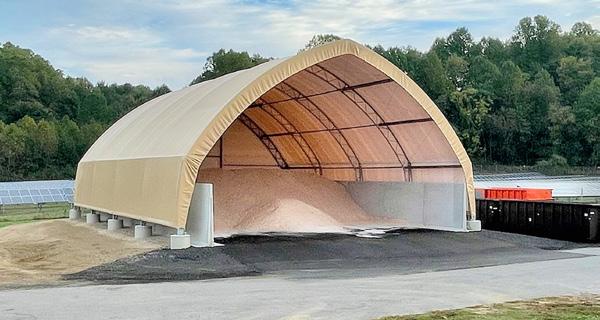




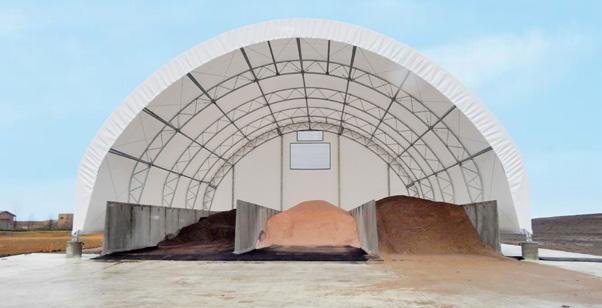







64 THE MUNICIPAL | JUNE 2023

JUNE 2023 | THE MUNICIPAL 65
Chilhowie and Farmville, Va.
By RAY BALOGH | The Municipal
Virginia, they say, is for lovers.
Apparently the state is also for sadists, judging from the litany of awkward and sometimes unsavory town names it has bestowed upon its citizens.
Welcome to the state where you can visit Chilhowie, Fries, Bumpass, Assawoman, Tightsqueeze, Skinquarter, Croaker, Dismal Town, Needmore, Lick Skillet, Dinwiddie, Butts and Burnt Chimney.
The pronunciation of other town names are rarely guessed correctly on the first try: Henrico (hen RYE ko), Matoaca (mah TOKE ah), Mattaponi (mat ah pa NYE), Jahnke (jank), Fauquier (faw keer), Aquia (ah KWAI ah), Gloucester (GLOST er), Zuni (zoo NAI), Poquoson (pah KO sen), Staunton (STAN ten), Schuyler (SKY lur), Botetourt (BOT a tot) and Wytheville (WITH vill, or WITH vool with a Southern drawl)
Here are two Virginia towns, one unusually named, the other a respite from the mispronunciation madness.
CHILHOWIE
The small town of Chilhowie, population 1,698, derives its name from a Cherokee word meaning “valley of many deer.”

The settlement started in 1748, consisting solely of a small fort constructed by Colonel James Patton and Dr. Thomas Walker to accommodate longhunter expeditionists. Today, only the chimneys of the original fort remain.
The town of Farmville in Virginia was the site of two notable Civil War battles and played a role in the birth of the Civil Rights movement as well. (Shutterstock.com)
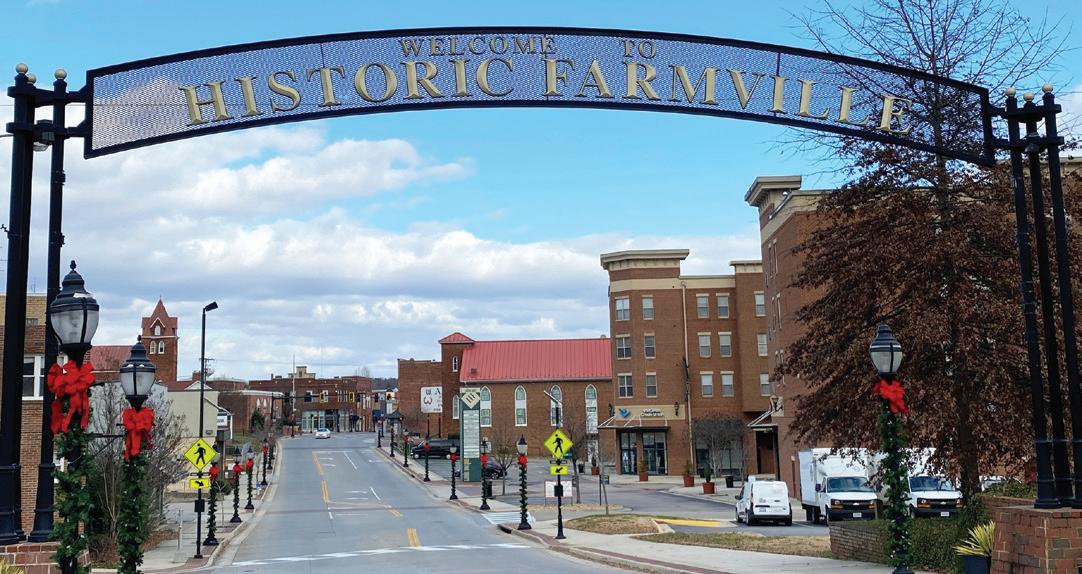
“Nature Boy” Buddy Landel; and Andrew “Nick” Cullop, who pitched in the major leagues from 1913 to 1921.
For more information, visit chilhowie.org.
FARMVILLE
Farmville, population 7,473, was notable long before its name was globally popularized by the internet game.
Famous historical figures who walked the streets of the town include Patrick Henry, Gen. Robert E. Lee and Dr. Martin Luther King Jr. Farmville is also recognized as the student birthplace of this nation’s civil rights movement when, in 1951, a student walkout at the all-black Moton High School launched the fight for integrated public education.
The high school, now the Moton Museum, operates a center for the study of civil rights in education.
Chilhowie is one of many cities and towns in Virginia whose name visitors find hard to pronounce. Today, cattle farms and apple orchards are mainstays of the region’s agricultural economy. (Photo courtesy of onlyinyourstate.com)
Several years later, settler Samuel Stalnaker converted the fort into a tavern and stagecoach inn known as the Town House, after which the community was also named until 1856 when the town was dubbed Greever’s Switch after the first station master. The municipality official became Chilhowie when it was incorporated in 1913.
A plethora of industries have contributed to the growth of the town throughout its history. Companies that produced pottery, brick, lumber, textiles, fertilizer, equipment and furniture all factored into Chilhowie’s sustained commercial success.
Today, cattle farms are a mainstay of the region’s agricultural economy. So is its apple production, which the town fetes every September with its Apple Festival, a weekend of family festivities, contests and entertainment.
The municipality is governed by a mayor and six council members. The police department consists of a police chief and seven officers. The volunteer fire department boasts a chief and 25 firefighters who protect not only Chilhowie but also neighboring communities.
Notable persons from Chilhowie include Chris Marion of the Little River Band; NASCAR driver Eric McClure; professional wrestler
The area was the site of two Civil War battles engaged in during Gen. Lee’s retreat days before his surrender at Appomattox Courthouse. The battlefield is now High Bridge Trail State Park and has been placed on the National Register of Historic Places.
The last major engagement of the Civil War, which took place on April 6, 1865, is commemorated in Sailor’s Creek Battlefield Historical State Park. The Overton-Hillsman House, which operated as a field hospital during the battle, is open to visitors June through August.
Visitors can enjoy a self-guided historic downtown walking tour that includes 26 stops with accompanying narration.
Farmville was comfortably integrated from early on. Freed African American laborers and white settlers worked side by side building canals for transportation of passengers and goods and constructing a church together. They were paid the same wages and lived together in the town’s neighborhoods.
Coal, brick making and mineral water were prominent industries during the formation of the town. With an abundance of Triassic clay, quite amenable for making bricks, one company produced 600,000 bricks a year.
Since 2016 there has been an Amish presence in Farmville. They migrated from the Lancaster settlement in Pennsylvania and now number about 200.
For more information, visit farmvilleva.com.
M What’s In A Name
66 THE MUNICIPAL | JUNE 2023





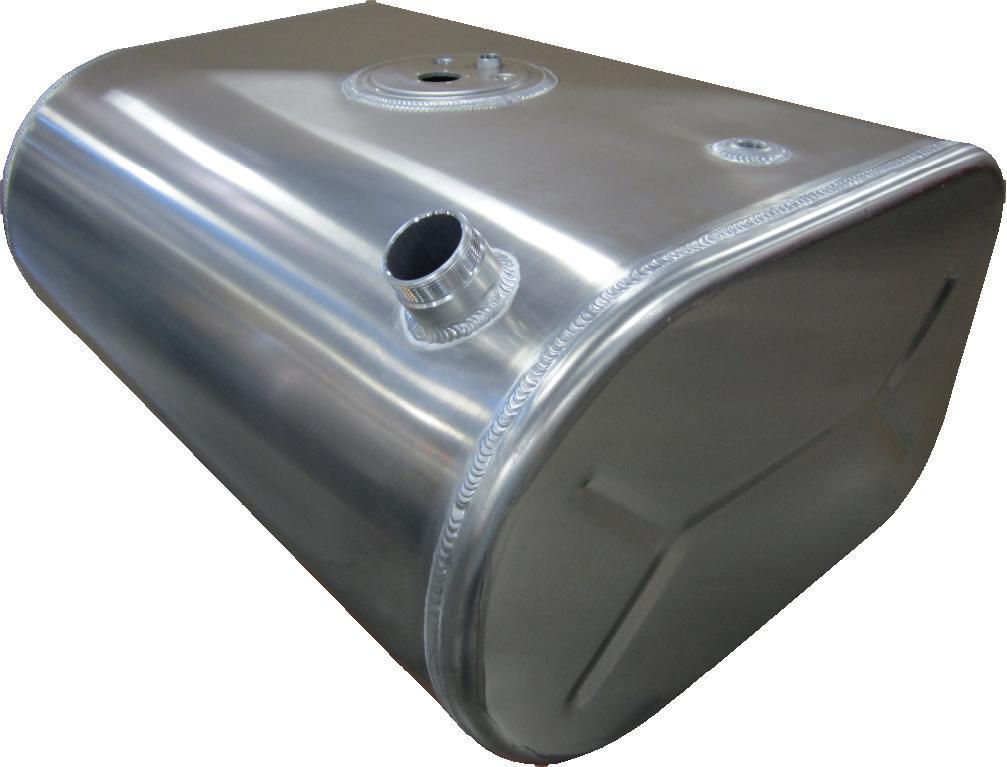





AT-IN-2001 As a factory-direct replacement and custom tank manufacturer, Alumitank can produce a wide variety of tanks in many configurations and quantities. Serving DOTs since 2001, Alumitank is the preferred choice of municipalities throughout the Midwest and across the nation. All Tanks FMCSA Approved MADE IN THE USA with PREMIUM American Materials AT-IN-3002 AT-GM-4001 REPLACE IT! We Make And Repair Aluminum Fuel And Hydraulic Tanks Round, Square, Rectangular and “D” - All openings to your specifications $760.06 55 Gallon Aluminum $942.93 GMC style 54 Gallon Tank $865.11 International style 50 Gallon Tank $1,527.71 International 4300 OEM - Steel Tank www.alumitank.com JUNE 2023 | THE MUNICIPAL 67
Create times the kids will remember
Family vacations are the stuff of which memories are made. Whether a road trip to Grandma and Grandpa’s, a week by the ocean or getting hands-on with a fossilized T-Rex at the history museum, children often treasure far into adulthood the summertime joys they experienced in new and exciting places alongside Mom and Dad and their siblings.
The website LawnLove.com looked at the 200 biggest U.S. cities to determine which offered the best vacations to take with kids. Child-friendly accommodations, attractions, restaurants and transportation were considered, along with affordability, safety and several other metrics. Many of the top-ranked cities are in warm and sunny locations, although not all: and at least one, Las Vegas, might be counterintuitive, but the city far outranked other Top 10 finalists when it came to interesting and engaging accommodations for the young ones.
It’s not too late to book a getaway before they go back to school. Pack those bags and consider heading for one of these major metropolises:
Source: https://lawnlove.com/blog/best-cities-kid-friendly-vacations/.

10 TOP
1. New York, N.Y.
2. Orlando, Fla.
3. Miami, Fla.
4. Las Vegas, Nev.
5. Chicago, Ill.
6. Tampa, Fla.
7. San Francisco, Calif.
8. Houston, Texas
9. Los Angeles, Calif.
10. San Antonio, Texas
68 THE MUNICIPAL | JUNE 2023
This index is provided courtesy of the publisher, who assumes no liability for errors or omissions. Advertiser Index A All Access Equipment .....................................7 Alumitank 67 American Landmaster 70 American Shoring ...................................... 60 Applied Concepts, Incorporated........................... 35 APWA PWX 16 B Bedlock Safety Products 60 BendPak Incorporated .................................. 51 Best Management Products ........................... 36-37 Blackburn Manufacturing Company 9 Bonnell Industries 61 Buyers Products Company ............................... 71 C Clearspan Fabric Structures .............................. 15 Curb Roller Manufacturing, LLC 50 Curbtender 65 D das Manufacturing 63 DR Power Equipment.................................... 15 E Ebac Industrial Products ................................. 35 Edinburg Auction Sales 57 F Fluid Control Services 60 G Global Environmental Products 5 Greystone Construction ................................. 64 I ICOM America Incorporated ................................3 L Landmark Studio & Design ............................. BACK Land Pride 35 M MurCal Incorporated ............................ Cover, 10-11 N National Construction Rentals ............................ 64 O The ODB Company 2 P Premier Manufacturing 34 R Rapidview LLC ......................................... 25 S SL Environmental Law Group .......................... 58-59 Switch-N-Go ........................................... 20 T Tech Products Incorporated 57 U UCoat It 43 V Vac-Con .............................................. 21 Vactor Manufacturing ................................... 43 Valtir LLC 24 VizCon 14 VSI Locks ............................................. 31 W Waytek Incorporated 42 Wisconsin Surplus Auction 42 JUNE 2023 | THE MUNICIPAL 69 M

70 THE MUNICIPAL | JUNE 2023

JUNE 2023 | THE MUNICIPAL 71



































 Sarah Wright | Editor
Sarah Wright | Editor






 By RAY BALOGH | The Municipal
By RAY BALOGH | The Municipal



















































































 By JULIE YOUNG | The Municipal
By JULIE YOUNG | The Municipal








































 By T. J. MULLEN | President BMP, Inc.
By T. J. MULLEN | President BMP, Inc.







 Mayor Satya Rhodes-Conway serves on various committees and task forces for the U.S. Conference of Mayors and the National League of Cities. (Photo provided by city of Madison, Wis.)
Mayor Satya Rhodes-Conway serves on various committees and task forces for the U.S. Conference of Mayors and the National League of Cities. (Photo provided by city of Madison, Wis.)































 Marine Park’s playground received a boost during the city of Blaine, Wash.’s, project to preserve and protect its coastline at the park. This lighthouse playground nods to the city’s nautical past. (Photo provided by the city of Blaine)
Marine Park’s playground received a boost during the city of Blaine, Wash.’s, project to preserve and protect its coastline at the park. This lighthouse playground nods to the city’s nautical past. (Photo provided by the city of Blaine)

















 The waterways are beautiful when lit up at night, but they also remain stunning in full sunlight. (Photo provided by the city of San Antonio)
The waterways are beautiful when lit up at night, but they also remain stunning in full sunlight. (Photo provided by the city of San Antonio)


























































